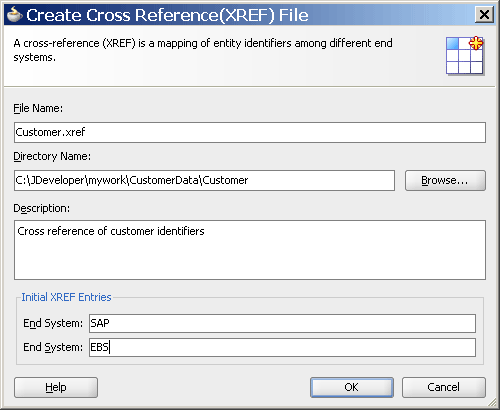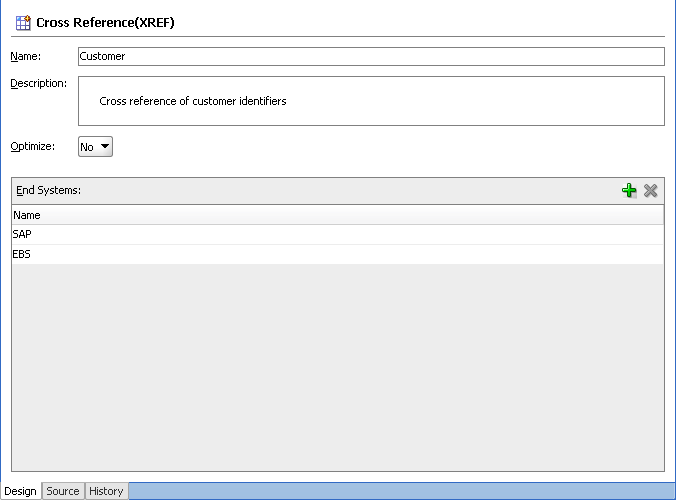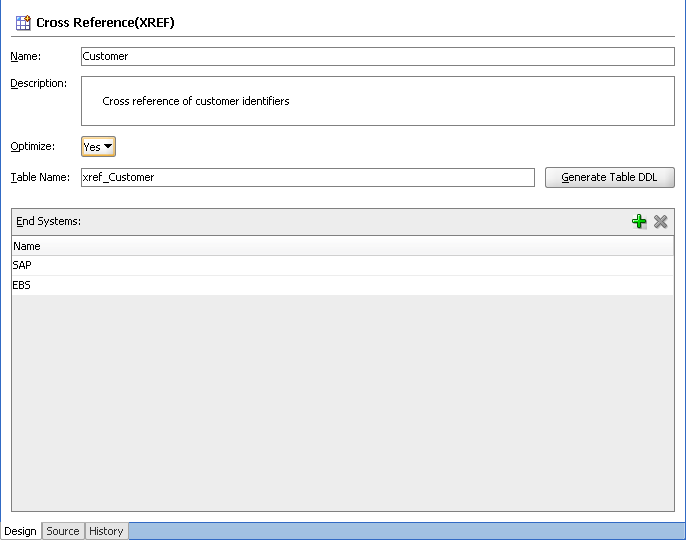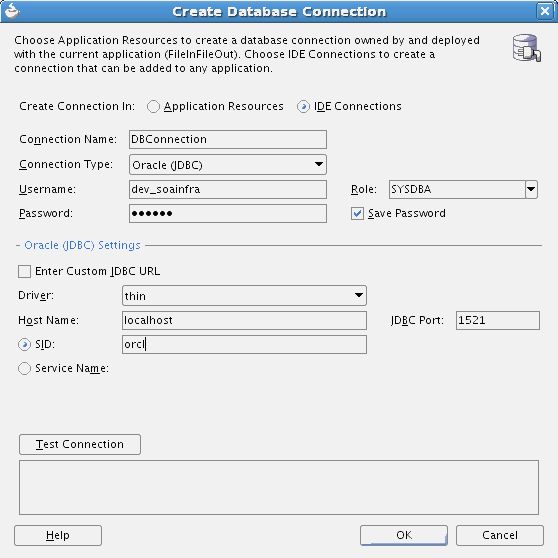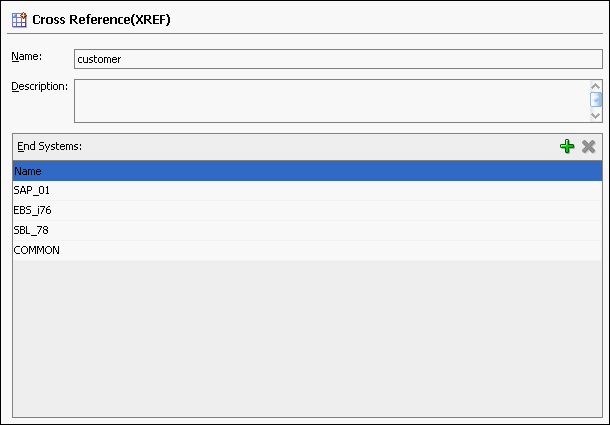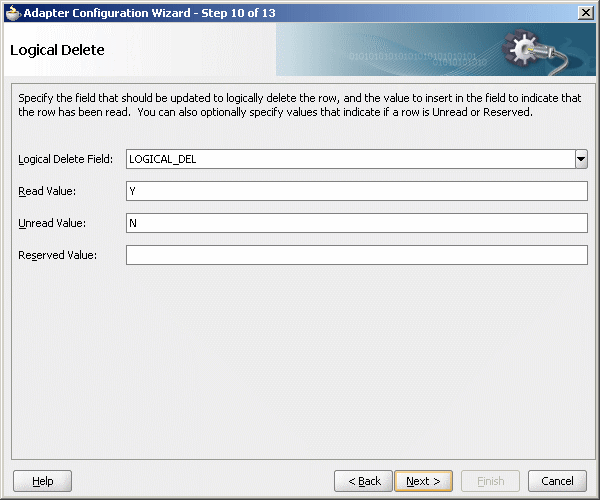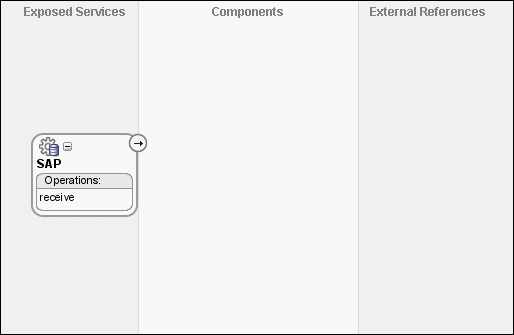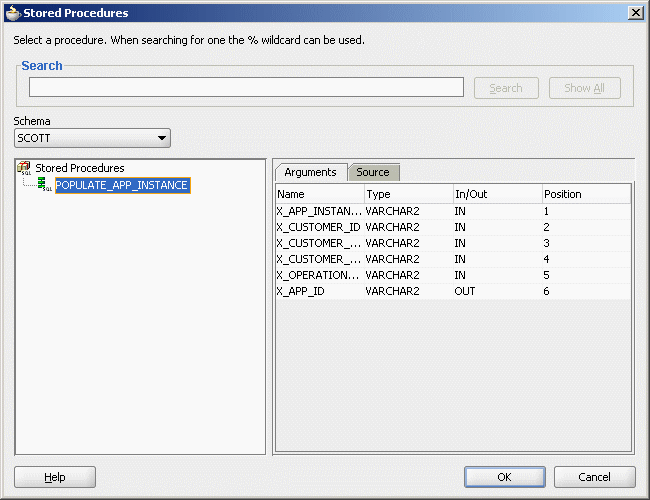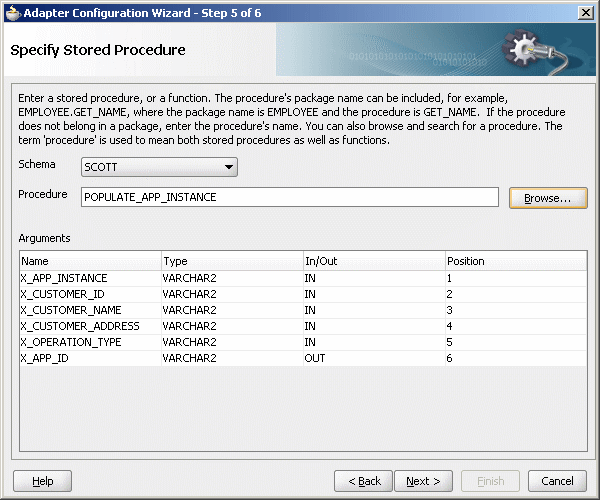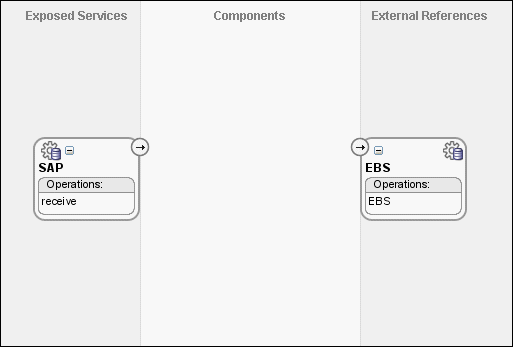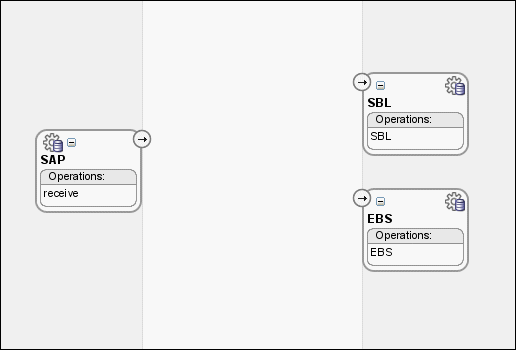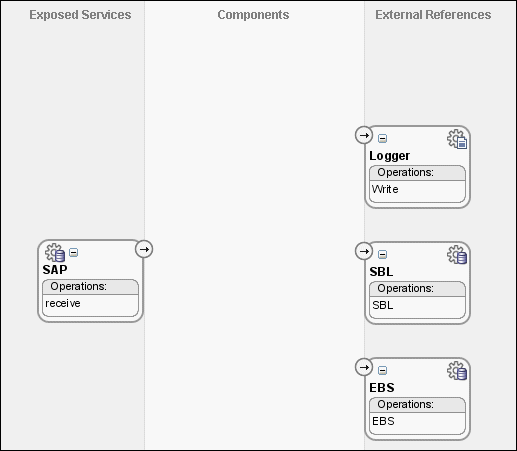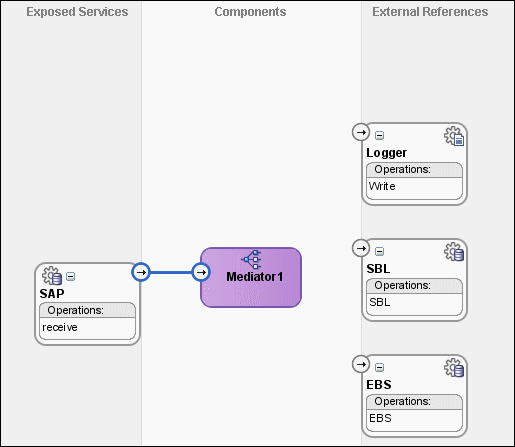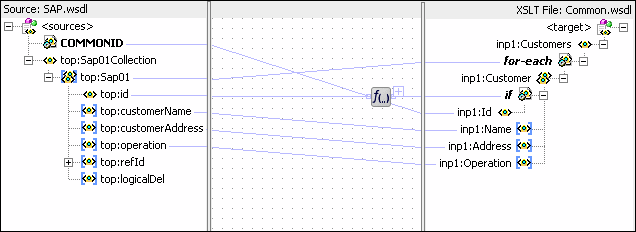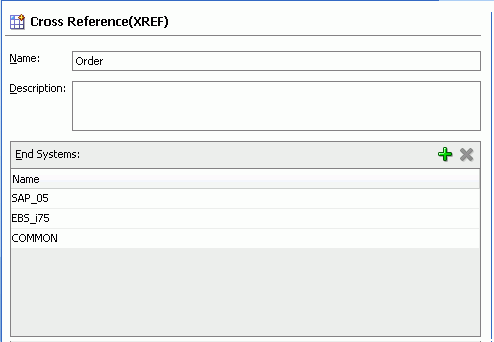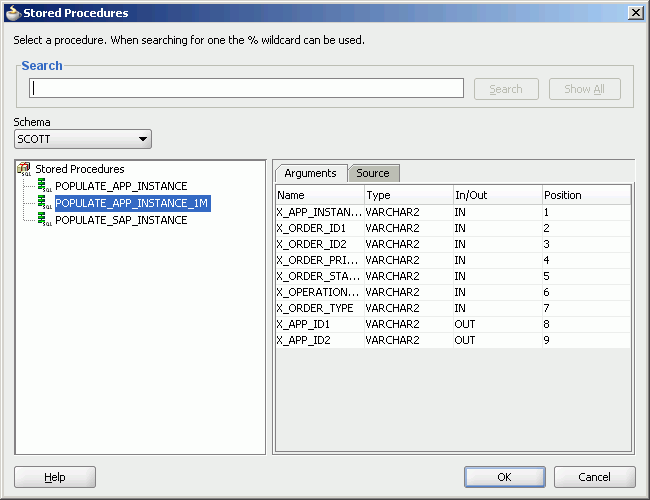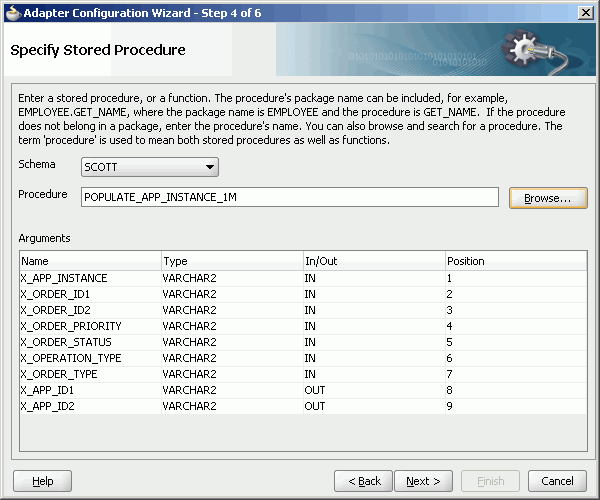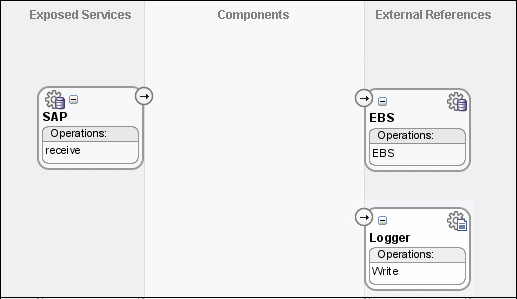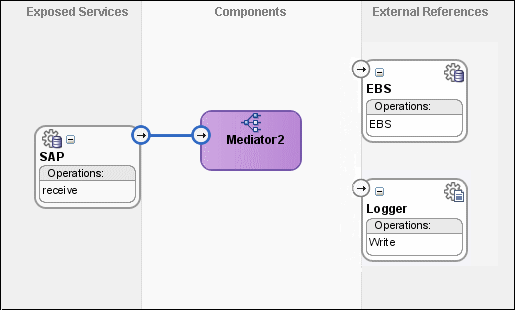43 Working with Cross References
This chapter includes the following sections:
43.1 Introduction to Cross References
Cross references enable you to dynamically map values for equivalent entities created in different applications.
Note:
The cross referencing feature enables you to dynamically integrate values between applications, whereas domain value maps enable you to specify values at design time and edit values at runtime. For more information about domain value maps, see Working with Domain Value Maps and Using Oracle SOA Composer with Domain Value Maps.
When you create or update objects in one application, you may also want to propagate the changes to other applications. For example, when a new customer is created in an SAP application, you may want to create an entry for the same customer in your Oracle E-Business Suite application named EBS. However, the applications that you are integrating may be using different entities to represent the same information. For example, for each new customer in an SAP application, a new row is inserted in its Customer database with a unique identifier such as SAP_001. When the same information is propagated to an Oracle E-Business Suite application and a Siebel application, the new row should be inserted with different identifiers such as EBS_1001 and SBL001. In such cases, you need some type of functionality to map these identifiers with each other so that they can be interpreted by different applications to be referring to the same entity. This can be done by using cross references.
43.2 Introduction to Cross Reference Tables
Cross references are stored in the form of tables. Table 43-1 shows a cross reference table containing information about customer identifiers in different applications.
Table 43-1 Cross Reference Table Sample
| SAP | EBS | SBL |
|---|---|---|
|
|
|
|
|
|
|
|
The identifier mapping is also required when information about a customer is updated in one application and the changes must be propagated to other applications. You can integrate different identifiers by using a common value integration pattern, which maps to all identifiers in a cross reference table. For example, you can add one more column named Common to the cross reference table shown in Table 43-1. The updated cross reference table then appears, as shown in Table 43-2.
Table 43-2 Cross Reference Table with Common Column
| SAP | EBS | SBL | Common |
|---|---|---|---|
|
|
|
|
|
|
|
|
|
|
Figure 43-1 shows how you can use common value integration patterns to map identifiers in different applications.
Figure 43-1 Common Value Integration Pattern Example
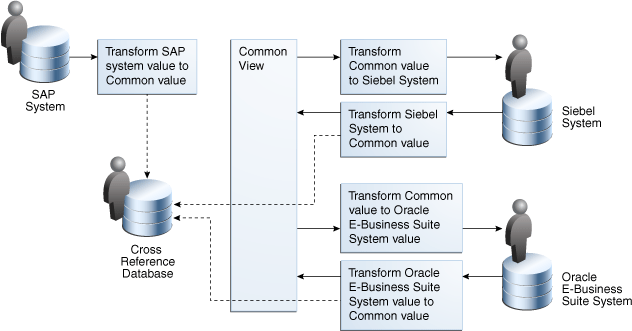
Description of "Figure 43-1 Common Value Integration Pattern Example"
A cross reference table consists of two parts: metadata and actual data. The metadata is saved as the .xref file created in Oracle JDeveloper, and is stored in the Metadata Services (MDS) repository as an XML file. By default, the actual data is stored in the XREF_DATA table of the database in the SOA Infrastructure database schema. You can also generate a custom database table for each cross reference entity. The database table depends on the metadata of the cross reference entity.
Consider the following two cross reference entities:
-
ORDERwith cross reference columnsSIEBEL,COMMON, andEBS, as shown in Table 43-3 -
CUSTOMERwith cross reference columnsEBS,COMMON, andPORTAL, as shown in Table 43-4
Table 43-3 ORDER Table
| Column Name | SIEBEL | COMMON | EBS |
|---|---|---|---|
|
|
|
|
|
|
|
|
|
Table 43-4 CUSTOMER Table
| Column Name | EBS | COMMON | PORTAL |
|---|---|---|---|
|
|
|
|
|
If you chose to save all the runtime data in one generic table, then the data is stored in the XREF_DATA table, as shown in Table 43-5.
Table 43-5 XREF_DATA Table
| XREF_TABLE_NAME | XREF_COLUMN_NAME | ROW_NUMBER | VALUE | IS_DELETED |
|---|---|---|---|---|
|
|
|
|
|
|
|
|
|
|
|
|
|
|
|
|
|
|
|
|
|
|
|
|
|
|
|
|
|
|
|
|
|
|
|
|
|
|
|
|
|
|
|
|
|
|
|
|
This approach has the following advantages:
-
The process of adding, removing, and modifying the columns of the cross reference entities is simple.
-
The process of creating and deleting cross reference entities from an application is straightforward.
However, this approach has the following disadvantages:
-
A large number of rows are generated in the database because each cross reference cell is mapped to a different row in the database. This reduces the performance of the queries.
-
In the generic table, the data for the columns
XREF_TABLE_NAMEandXREF_COLUMN_NAMEis repeated across a large number of rows.
To overcome these problems, you can generate a custom database table for each cross reference entity. The custom database tables depend on the metadata of the cross reference entities. For example, for the XREF_ORDER table and XREF_CUSTOMER table, you can generate the custom database tables shown in Table 43-6 and Table 43-7.
Table 43-6 XREF_ORDER Table
| ROW_ID | SIEBEL | COMMON | EBS |
|---|---|---|---|
|
|
|
|
|
|
|
|
|
Table 43-7 XREF_CUSTOMER Table
| ROW_ID | EBS | COMMON | PORTAL |
|---|---|---|---|
|
|
|
|
|
This approach requires you to execute Data Definition Language (DDL) scripts to generate the custom database tables. For more information about custom database tables, see How to Create Custom Database Tables.
43.3 Oracle Data Integrator Support for Cross Referencing
Oracle Data Integrator (ODI) achieves data integration through an E-LT (extract, load, transform) model. You can use ODI to help with your cross-referencing needs. ODI provides three Knowledge Modules for handling SOA cross references that perform the following functions: Populate the cross-reference table, create a common ID for the target table, push the common ID and the source primary key to the cross-reference table, and create and push a unique row number that creates the cross reference between the source primary key and the common ID. With the modules, you can create an integration interface that both loads a target table from several source tables and handles cross-references between one of the sources and the target.
For more information about ODI and cross referencing, see Oracle SOA Suite Cross References in Connectivity and Knowledge Modules Guide for Oracle Data Integrator Developer's Guide.
43.4 Creating and Modifying Cross Reference Tables
You can create cross references tables in a SOA composite application and then use it with a BPEL process service component or an Oracle Mediator service component during transformations.
Note:
You can also create cross-reference tables in Service Bus projects and use them in message flows during transformations.
43.4.2 What Happens When You Create a Cross Reference
A file with extension .xref gets created and appears in the Applications window. All .xref files are based on the schema definition (XSD) file shown in the following example:
<?xml version="1.0" encoding="UTF-8" ?>
<schema xmlns="http://www.w3.org/2001/XMLSchema"
targetNamespace="http://xmlns.oracle.com/xref"
xmlns:tns="http://xmlns.oracle.com/xref" elementFormDefault="qualified">
<element name="xref" type="tns:xrefType"/>
<complexType name="xrefType">
<sequence>
<element name="table">
<complexType>
<sequence>
<element name="description" type="string" minOccurs="0"
maxOccurs="1"/>
<element name="columns" type="tns:columnsType" minOccurs="0"
maxOccurs="1"/>
<element name="rows" type="tns:rowsType" maxOccurs="1"
minOccurs="0"/>
</sequence>
<attribute name="name" type="string" use="required"/>
</complexType>
</element>
</sequence>
</complexType>
<complexType name="columnsType">
<sequence>
<element name="column" minOccurs="1" maxOccurs="unbounded">
<complexType>
<attribute name="name" type="string" use="required"/>
</complexType>
</element>
</sequence>
</complexType>
<complexType name="rowsType">
<sequence>
<element name="row" minOccurs="1" maxOccurs="unbounded">
<complexType>
<sequence>
<element name="cell" minOccurs="1" maxOccurs="unbounded">
<complexType>
<attribute name="colName" type="string" use="required"/>
</complexType>
</element>
</sequence>
</complexType>
</element>
</sequence>
</complexType>
</schema>43.4.3 How to Create Custom Database Tables
As mentioned previously, all the runtime data by default gets stored in the XREF_DATA table. If you want to create custom database tables, then perform the following steps.
To create custom database tables:
For custom database tables, two additional attributes, namely mode and dbtable, are added to the schema definition mentioned in What Happens When You Create a Cross Reference. They are added for the table element in the following way:
<attribute name="mode" type="string" default="generic" /> <attribute name="dbtable" type="string" default="xref_data"/>
43.5 Populating Cross Reference Tables
You can create a cross reference table in a SOA composite application in Oracle JDeveloper and then use it to look up column values at runtime. However, before using a cross reference to look up a particular value, you must populate it at runtime. You can use the cross reference XPath functions to populate the cross-reference tables. The XPath functions enable you to populate a cross reference column, perform lookups, and delete a column value. These XPath functions can be used in the Expression Builder dialog to create an expression or in the XSLT Mapper to create transformations. For example, you can use the xref:populateXRefRow function to populate a cross reference column with a single value and the xref:populateXRefRow1M function to populate a cross reference column with multiple values.
You can access the Expression Builder dialog through an assign activity, an XSL transformation, or the filtering functionality of a BPEL process service component or an Oracle Mediator service component. Figure 43-6 shows how you can select the cross reference functions in the Expression Builder dialog.
Figure 43-6 Expression Builder Dialog with Cross Reference Functions
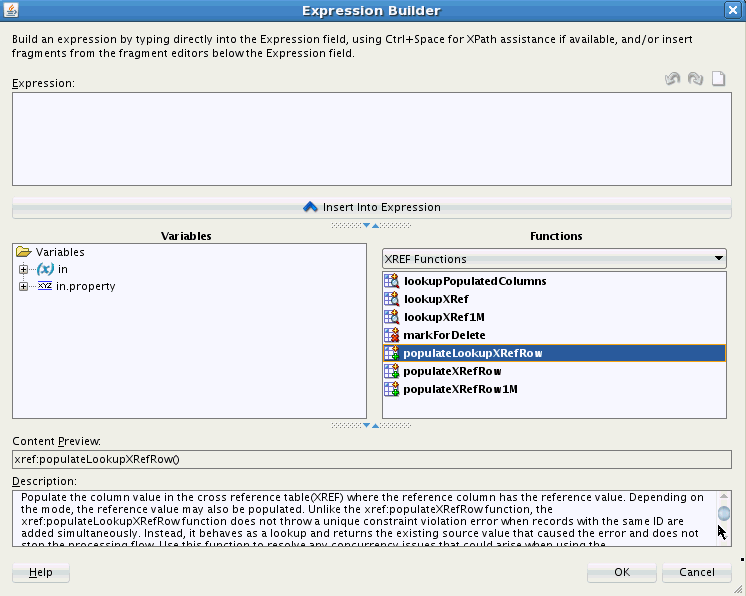
Description of "Figure 43-6 Expression Builder Dialog with Cross Reference Functions"
The XSLT Mapper is displayed when you create an XSL file to transform data from one XML schema to another. Figure 43-7 shows how you can select the cross reference functions in the XSLT Mapper.
Figure 43-7 XSLT Mapper Dialog with Cross Reference Functions
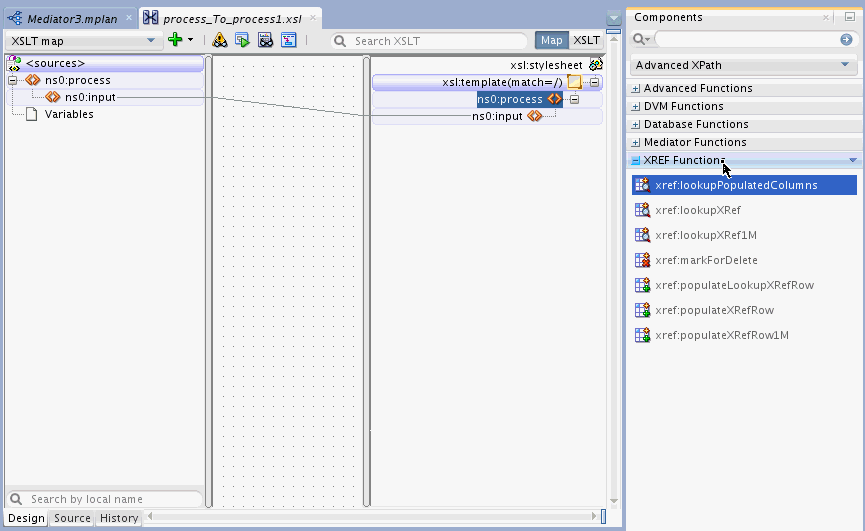
Description of "Figure 43-7 XSLT Mapper Dialog with Cross Reference Functions"
A cross reference table must be populated at runtime before using it. By default, the data is stored in the XREF_DATA table under the SOA Infrastructure database schema. You can use the xref:populateXRefRow function to populate a cross reference column with a single value and the xref:populateXRefRow1M function to populate a cross reference column with multiple values.
Note:
You can also store the data in a different database schema by configuring a data source in the following way:
-
The JNDI name of the data source should be
jdbc/xref. -
The
ORACLE_HOME/rcu/integration/soainfra/sql/xref/createschema_xref_oracle.sqlfile should be loaded to create theXREF_DATAtable in this data source.
43.5.1 About the xref:populateXRefRow Function
The xref:populateXRefRow function populates a cross reference column with a single value. The xref:populateXRefRow function returns a string value, which is the cross reference value being populated. For example, as shown in Table 43-8, the Order table has the following columns: EBS, Common, and SBL with values E100, 100, and SBL_001 respectively.
Table 43-8 Cross Reference Table with Single Column Values
| EBS | Common | SBL |
|---|---|---|
|
|
|
|
Note:
If you find you have concurrency issues when using this function, you can also use the populateLookupXRefRow function. The populateLookupXRefRow function should only be used in cases where simultaneous updates are being made, resulting in unique constraint violations. This function is described under About the xref:populateLookupXRefRow Function.
The syntax of the xref:populateXRefRow function is shown in the following example:
xref:populateXRefRow(xrefLocation as string, xrefReferenceColumnName as string, xrefReferenceValue as string, xrefColumnName as string, xrefValue as string, mode as string) as string
Parameters
-
xrefLocation: The cross reference table URI. -
xrefReferenceColumnName: The name of the reference column. -
xrefReferenceValue: The value corresponding to the reference column name. -
xrefColumnName: The name of the column to be populated. -
xrefValue: The value to be populated in the column. -
mode: The mode in which thexref:populateXRefRowfunction populates the column. You can specify any of the following values:ADD,LINK, orUPDATE. Table 43-9 describes these modes.
Table 43-9 xref:populateXRefRow Function Modes
| Mode | Description | Exception Reasons |
|---|---|---|
|
|
Adds the reference value and the value to be added. For example, the following mode: xref:populateXRefRow("customers.xref"
,"EBS","EBS100", "Common","CM001",
"ADD")Adds the reference value |
Exceptions can occur for the following reasons:
|
|
|
Adds the cross reference value corresponding to the existing reference value. For example, the following mode: xref:populateXRefRow("customers.xref"
,"Common","CM001","SBL","SBL_
001","LINK") Links the value |
Exceptions can occur for the following reasons:
|
|
|
Updates the cross reference value corresponding to an existing reference column-value pair. For example, the following mode: xref:populateXRefRow("customers.xref"
,"SBL","SBL_001", "SBL","SBL_
1001","UPDATE")Updates the value |
Exceptions can occur for the following reasons:
|
Note:
The mode parameter values are case-sensitive and should be specified in upper case only, as shown in Table 43-9.
Table 43-10 describes the xref:populateXRefRow function modes and exception conditions for these modes.
Table 43-10 xref:populateXRefRow Function Results with Different Modes
| Mode | Reference Value | Value to be Added | Result |
|---|---|---|---|
|
|
|
|
Success Exception Exception |
|
|
|
|
Exception Success Exception |
|
|
|
|
Exception Exception Success |
43.5.2 About the xref:populateLookupXRefRow Function
Like the xref:populateXRefRow function, the xref:populateLookupXRefRow function populates a cross reference column with a single value. Unlike the xref:populateXRefRow function, the xref:populateLookupXRefRow function does not throw a unique constraint violation error when records with the same ID are added simultaneously. Instead, it behaves as a lookup and returns the existing source value that caused the error and does not stop the processing flow. Use this function to resolve any concurrency issues that could arise when using the xref:populateXRefRow function.
The xref:populateLookupXRefRow function returns a string value, which is the cross reference value being populated or, with a unique constraint violation, the cross reference value that was already populated by the first committed thread. For example, as shown in Table 43-8, the XREF_CUSTOMER_DATA table has the following columns: EBS, Common, and SBL. The xref:populateLookupXRefRow function is invoked by two threads in parallel with following values:
-
Thread One:
xref: populateLookupXRefRow ("default/xref/example.xref", "EBS", "EBS100", "Common" "CM001", "ADD") -
Thread Two:
xref: populateLookupXRefRow ("default/xref/example.xref", "EBS", "EBS100", "Common" "CM002", "ADD")
The table is populated as shown in Table 43-11. Since thread one is committed first, thread two returns "CM001" to the caller.
Table 43-11 Cross Reference Table Populated by xref:populateLookupXRefRow
| EBS | Common | SBL |
|---|---|---|
|
|
|
The syntax of the xref:populateLookupXRefRow function is shown in the following example:
xref:populateLookupXRefRow(xrefMetadataURI as string, xrefReferenceColumnName as string, xrefReferenceValue as string, xrefColumnName as string, xrefValue as string, mode as string) as string
Parameters
-
xrefMetadataURI: The cross reference table URI. -
xrefReferenceColumnName: The name of the reference column. -
xrefReferenceValue: The value corresponding to the reference column name. -
xrefColumnName: The name of the column to be populated. -
xrefValue: The value to be populated in the column. -
mode: The mode in which thexref:populateXRefRowfunction populates the column. You can specifyADDorLINK. Table 43-10 describes these modes and exception conditions for the modes.
Note:
The mode parameter values are case-sensitive and should be specified in upper case only.
Table 43-12 xref:populateLookupXRefRow Function Results with Different Modes
| Mode | Reference Value | Value to be Added | Result |
|---|---|---|---|
|
|
|
|
Success Exception (Success only when Exception is Unique constraint violation) Exception (Success only when Exception is Unique constraint violation) |
|
|
|
|
Exception Success Exception |
Usage Notes
-
When using a custom table approach, you must add the primary constraint on the columns that must be unique in the cross-reference table. Using Table 43-11 as an example, the SQL statement is similar to the following:
alter table xref_customer_data add constraint xref_vnx_data_pk primary key (common, ebs);
Populate the primary constraint columns first and then populate the remaining columns in subsequent calls.
-
This function should not be used for inserting cross references for primary objects, since this could mask data inconsistency issues. Only use the function for secondary objects to a main dependent object. For example, do not use the function to determine whether an account already exists when creating customer accounts; but do use it if the addresses in those customer accounts are being synchronized.
43.5.3 About the xref:populateXRefRow1M Function
Two values in an end system can correspond to a single value in another system. In such a scenario, you should use the xref:populateXRefRow1M function to populate a cross reference column with a value. For example, as shown in Table 43-13, the SAP_001 and SAP_0011 values refer to one value of the EBS and SBL applications. To populate columns such as SAP, you can use the xref:populateXRefRow1M function.
Table 43-13 Cross Reference Table with Multiple Column Values
| SAP | EBS | SBL |
|---|---|---|
|
|
|
|
|
|
|
|
The syntax of the xref:populateXRefRow1M function is shown in the following example:
xref:populateXRefRow1M(xrefLocation as string, xrefReferenceColumnName as string, xrefReferenceValue as string, xrefColumnName as string, xrefValue as string, mode as string) as string
Parameters
-
xrefLocation: The cross reference URI. -
xrefReferenceColumnName: The name of the reference column. -
xrefReferenceValue: The value corresponding to the reference column name. -
xrefColumnName: The name of the column to be populated. -
xrefValue: The value to be populated in the column. -
mode: The mode in which thexref:populateXRefRowfunction populates the column. You can specify either of the following values:ADDorLINK. Table 43-14 describes these modes:
Table 43-14 xref:populateXRefRow1M Function Modes
| Mode | Description | Exception Reasons |
|---|---|---|
|
|
Adds the reference value and the value to be added. For example, the following mode: xref:populateXRefRow1M("customers.xref","
EBS","EBS_1002", "SAP","SAP_0011","ADD")Adds the reference value |
Exceptions can occur for the following reasons:
|
|
|
Adds the cross reference value corresponding to the existing reference value. For example, the following mode: xref:populateXRefRow1M("customers.xref","
EBS","EBS_1002", "SAP","SAP_002","LINK") Links the value |
Exceptions can occur for the following reasons:
|
Table 43-15 describes the xref:populateXRefRow1M function modes and exception conditions for these modes.
Table 43-15 xref:populateXRefRow1M Function Results with Different Modes
| Mode | Reference Value | Value to be Added | Result |
|---|---|---|---|
|
|
|
|
Success Exception Exception |
|
|
|
|
Exception Success Exception |
43.5.4 How to Populate a Column of a Cross Reference Table
To populate a column of a cross reference table:
-
In the XSLT Mapper, expand the trees in the Source and Target panes.
-
Drag and drop a source element to a target element.
-
In the Components window, select Advanced.
-
Select XREF Functions.
-
Drag and drop the populateXRefRow function to the line that connects the source object to the target object.
A populateXRefRow icon appears on the connecting line.
-
Double-click the populateXRefRow icon.
The Edit Function – populateXRefRow dialog is displayed, as shown in Figure 43-8.
Figure 43-8 Edit Function – populateXRefRow Dialog

Description of "Figure 43-8 Edit Function – populateXRefRow Dialog" -
Specify the following values for the fields in the Edit Function – populateXRefRow dialog:
-
In the xrefLocation field, enter the location URI of the cross reference file.
Click Browse to the right of the xrefLocation field to select the cross reference file. You can select an already-deployed cross reference from MDS and also from a shared location in MDS using the Resource Palette.
-
In the referenceColumnName field, enter the name of the cross reference column.
Click Browse to the right of the referenceColumnName field to select a column name from the columns defined for the cross reference you previously selected.
-
In the referenceValue field, you can manually enter a value or press Ctrl-Space to launch the XPath Building Assistant. Press the up and down keys to locate an object in the list and press Enter to select that object.
-
In the columnName field, enter the name of the cross reference column.
Click the Browse icon to the right of the columnName field to select a column name from the columns defined for the cross reference you previously selected.
-
In the value field, you can manually enter a value or press Ctrl-Space to launch the XPath Building Assistant.
-
In the mode field, enter a mode in which you want to populate the cross reference table column. For example, enter
ADD.You can also click Browse to select a mode. The Select Populate Mode dialog is displayed from which you can select a mode.
-
-
Click OK.
A populated Edit Function – populateXRefRow dialog is shown in Figure 43-9.
Figure 43-9 Populated Edit Function – populateXRefRow Dialog
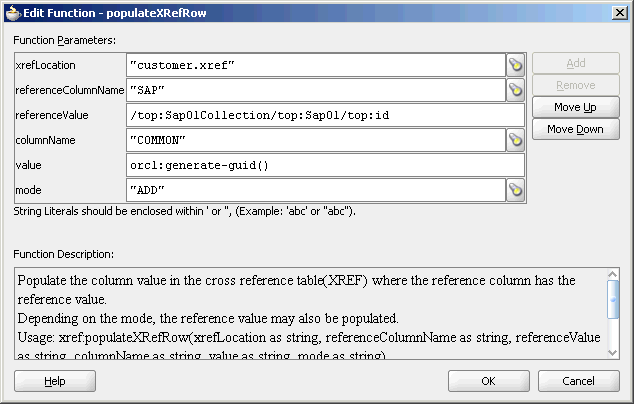
Description of "Figure 43-9 Populated Edit Function – populateXRefRow Dialog"
43.6 Looking Up Cross Reference Tables
After populating the cross reference table, you can use it to look up a value. The xref:lookupXRef and xref:lookupXRef1M functions enable you to look up a cross reference for single and multiple values, respectively.
43.6.1 About the xref:lookupXRef Function
You can use the xref:lookupXRef function to look up a cross reference column for a value that corresponds to a value in a reference column. For example, the following function looks up the Common column of the cross reference tables described in Table 43-2 for a value corresponding to the SAP_001 value in the SAP column.
xref:lookupXRef("customers.xref","SAP","SAP_001","Common",true())
The syntax of the xref:lookupXRef function is shown in the following example:
xref:lookupXRef(xrefLocation as string, xrefReferenceColumnName as string, xrefReferenceValue as string, xrefColumnName as string, needAnException as boolean) as string
Parameters
-
xrefLocation: The cross reference URI. -
xrefReferenceColumnName: The name of the reference column. -
xrefReferenceValue: The value corresponding to the reference column name. -
xrefColumnName: The name of the column to be looked up for the value. -
needAnException: When the value is set totrue, an exception is thrown if the value is not found. Otherwise, an empty value is returned.
Exception Reasons
At runtime, an exception can occur for the following reasons:
-
The cross reference table with the given name is not found.
-
The specified column names are not found.
-
The specified reference value is empty.
-
Multiple values are found.
43.6.2 About the xref:lookupXRef1M Function
You can use the xref:lookupXRef1M function to look up a cross reference column for multiple values corresponding to a value in a reference column. The xref:lookupXRef1M function returns a node-set containing multiple nodes. Each node in the node-set contains a value.
For example, the following function looks up the SAP column of Table 43-13 for multiple values corresponding to the EBS_1001 value in the EBS column:
xref:lookupXRef1M("customers.xref","EBS","EBS_1001","SAP",true())
The syntax of the xref:lookupXRefRow1M function is shown in the following example:
xref:lookupXRef1M(xrefLocation as String, xrefReferenceColumnName as String, xrefReferenceValue as String, xrefColumnName as String, needAnException as boolean) as node-set
Parameters
-
xrefLocation: The cross reference URI. -
xrefReferenceColumnName: The name of the reference column. -
xrefReferenceValue: The value corresponding to the reference column name. -
xrefColumnName: The name of the column to be looked up for the value. -
needAnException: If this value is set totrue, an exception is thrown when the referenced value is not found. Otherwise, an empty node-set is returned.
Example of the xref:lookupXRefRow1M Function
Consider the Order table shown in Table 43-16 with the following three columns: Siebel, Billing1, and Billing2.
Table 43-16 Order Table
| Siebel | Billing1 | Billing2 |
|---|---|---|
|
|
|
|
|
|
|
For 1:1 mapping, the xref:lookupPopulatedColumns("Order","Siebel","100","false") method returns the values shown in the following example:
<column name="BILLING1">101</column> <column name="BILLING2">102</column>
In this case, both the columns, Billing1 and Billing2, are populated.
For 1:M mapping, the xref:lookupPopulatedColumns("Order","Siebel","110","false") method returns the values shown in the following example:
<column name="BILLING2">111</column> <column name="BILLING2">112</column>
In this case, Billing1 is not populated.
Exception Reasons
An exception can occur for the following reasons:
-
The cross reference table with the given name is not found.
-
The specified column names are not found.
-
The specified reference value is empty.
43.6.3 About the xref:lookupPopulatedColumns Function
You can use the xref:lookupPopulatedColumns function to look up all the populated columns for a given cross reference table, a cross reference column, and a value. The xref:lookupPopulatedColumns function returns a node-set with each node containing a column name and the corresponding value.
The syntax of the xref:LookupPopulatedColumns function is shown in the following example:
xref:LookupPopulatedColumns(xrefTableName as String,xrefColumnName as String,xrefValue as String,needAnException as boolean)as node-set
Parameters
-
xrefTableName: The name of the reference table. -
xrefColumnName: The name of the reference column. -
xrefValue: The value corresponding to the reference column name. -
needAnException: If this value is set totrue, then an exception is thrown when no value is found in the referenced column. Otherwise, an empty node-set is returned.
Exception Reasons
An exception can occur for the following reasons:
-
The cross reference table with the given name is not found.
-
The specified column names are not found.
-
The specified reference value is empty.
43.6.4 How to Look Up a Cross Reference Table for a Value
To look up a cross reference table column:
-
In the XSLT Mapper, expand the trees in the Source and Target panes.
-
Drag and drop the source element to the target element.
-
In the Components window, select Advanced.
-
Select XREF Functions.
-
Drag and drop the lookupXRef function to the line that connects the source object to the target object.
A lookupXRef icon appears on the connecting line.
-
Double-click the lookupXRef icon.
The Edit Function – lookupXRef dialog is displayed, as shown in Figure 43-10.
Figure 43-10 Edit Function – lookupXRef Dialog
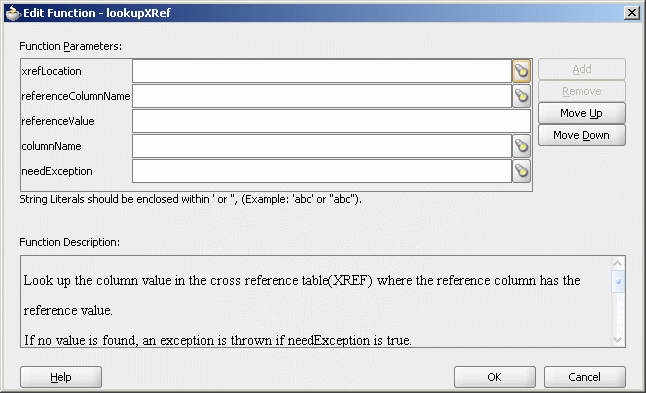
Description of "Figure 43-10 Edit Function – lookupXRef Dialog" -
Specify the following values for the fields in the Edit Function – lookupXRef dialog:
-
In the xrefLocation field, enter the location URI of the cross reference file.
Click Browse to the right of the xrefLocation field to select the cross reference file. You can select an already deployed cross reference from MDS and also from a shared location in MDS by using the Resource Palette.
-
In the referenceColumnName field, enter the name of the cross reference column.
Click Browse to the right of the referenceColumnName field to select a column name from the columns defined for the cross reference you previously selected.
-
In the referenceValue field, you can manually enter a value or press Ctrl-Space to use the XPath Building Assistant. Press the up and down keys to locate an object in the list and press Enter to select that object.
-
In the columnName field, enter the name of the cross reference column.
Click Browse to the right of the columnName field to select a column name from the columns defined for the cross reference you previously selected.
-
Click Browse to the right of needException field. The Need Exception dialog is displayed. Select Yes to raise an exception if no value is found. Otherwise, select No.
-
-
Click OK.
A populated Edit Function – lookupXRef dialog is shown in Figure 43-11.
Figure 43-11 Populated Edit Function – lookupXRef Dialog
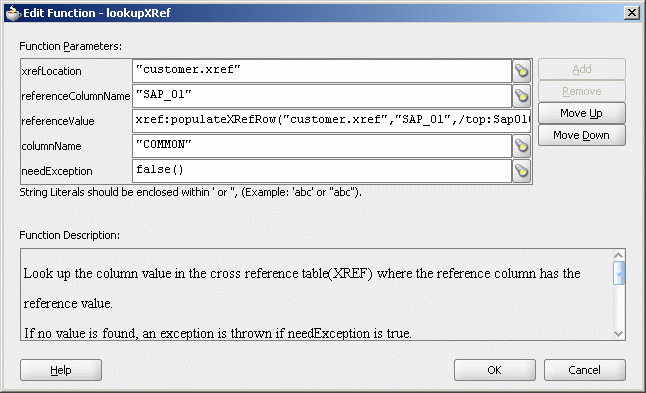
Description of "Figure 43-11 Populated Edit Function – lookupXRef Dialog"
43.7 Deleting a Cross Reference Table Value
You can use the xref:markForDelete function to delete a value in a cross reference table. The row, containing the column value passed to the function, is deleted from the XREF_DATA table and moved to the XREF_DELETED_DATA table. This function returns true if the deletion is successful. Otherwise, it returns false.
A cross reference table row should have at least two mappings. If you have only two mappings in a row and you mark one value for deletion, then the value in another column is also deleted.
The syntax for the xref:markForDelete function is shown in the following example:
xref:markForDelete(xrefTableName as string, xrefColumnName as string, xrefValueToDelete as string) return as boolean
Parameters
-
xrefTableName: The cross reference table name. -
xrefColumnName: The name of the column that contains the value to be deleted. -
xrefValueToDelete: The value to be deleted.
Exception Reasons
An exception can occur for the following reasons:
-
The cross reference table with the given name is not found.
-
The specified column name is not found.
-
The specified value is empty.
-
The specified value is not found in the column.
-
Multiple values are found.
43.7.1 How to Delete a Cross Reference Table Value
To delete a cross reference table value:
-
In the XSLT Mapper, expand the trees in the Source and Target panes.
-
Drag and drop the source element to the target element.
-
In the Components window, select Advanced.
-
Select XREF Functions.
-
Drag and drop the markForDelete function to the line that connects the source object to the target object.
A markForDelete icon appears on the connecting line.
-
Double-click the markForDelete icon.
The Edit Function – markForDelete dialog is displayed, as shown in Figure 43-12.
Figure 43-12 Edit Function – markForDelete Dialog
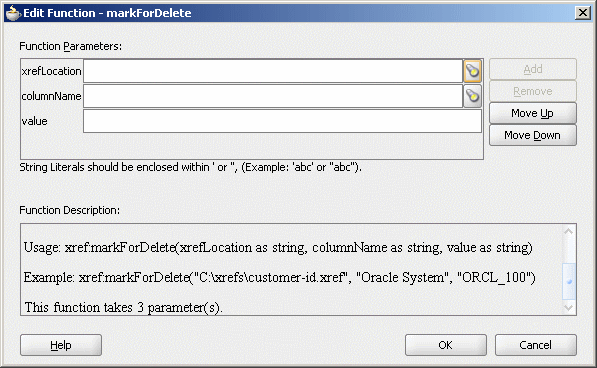
Description of "Figure 43-12 Edit Function – markForDelete Dialog" -
Specify the following values for the fields in the Edit Function – markForDelete dialog:
-
In the xrefLocation field, enter the location URI of the cross reference file.
Click the Search icon to the right of the xrefLocation field to select the cross reference file. You can select an already deployed cross reference from MDS and also from a shared location in MDS by using the Resource Palette.
-
In the columnName field, enter the name of cross reference table column.
Click the Search icon to the right of the columnName field to select a column name from the columns defined for the cross reference you previously selected.
-
In the Value field, manually enter a value or press Ctrl-Space to launch the XPath Building Assistant. Press the up and down keys to locate an object in the list and press Enter to select that object.
A populated Edit Function – markForDelete dialog is shown in Figure 43-13.
Figure 43-13 Populated Edit Function – markForDelete Dialog
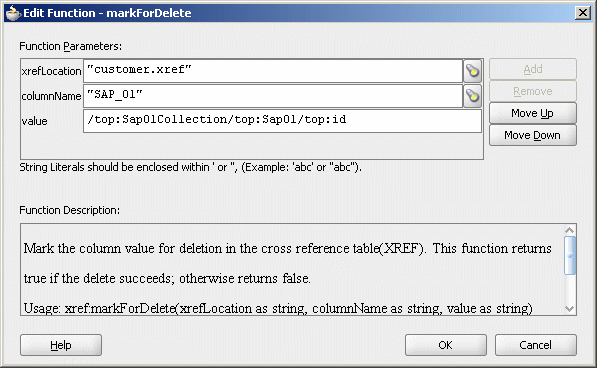
Description of "Figure 43-13 Populated Edit Function – markForDelete Dialog" -
-
Click OK.
43.8 Creating and Running the Cross Reference Use Case
This cross reference use case implements an integration scenario between Oracle EBS, SAP, and Siebel instances. In this use case, when an insert, update, or delete operation is performed on the SAP_01 table, the corresponding data is inserted or updated in the EBS and SBL tables. Figure 43-14 provides an overview of this use case.
Figure 43-14 XrefCustApp Use Case in SOA Composite Editor
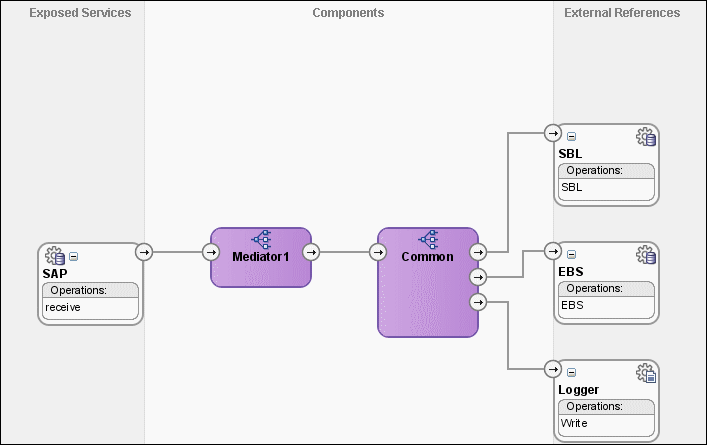
Description of "Figure 43-14 XrefCustApp Use Case in SOA Composite Editor"
43.8.1 How to Create the Use Case
This section provides the design-time tasks for creating, building, and deploying your SOA Composite application. These tasks should be performed in the order in which they are presented.
43.8.1.1 Task 1: How to Configure the Oracle Database and Database Adapter
To configure the Oracle database and database adapter:
43.8.1.2 Task 2: How to Create an Oracle JDeveloper Application and a Project
To create an Oracle JDeveloper application and a project:
43.8.1.3 Task 3: How to Create a Cross Reference
After creating an application and a project for the use case, you must create a cross reference table.
To create a cross reference table:
43.8.1.5 Task 5: How to Create EBS and SBL External References
To create EBS and SBL external references:
43.8.1.6 Task 6: How to Create the Logger File Adapter External Reference
To create the Logger file adapter external reference:
43.8.1.7 Task 7: How to Create an Oracle Mediator Service Component
To create an Oracle Mediator service component:
43.8.1.8 Task 8: How to Specify Routing Rules for an Oracle Mediator Service Component
You must specify routing rules for the following operations:
-
Insert
-
Update
-
UpdateID
-
Delete
43.8.1.8.1 To create routing rules for an insert operation:
-
Double-click the Mediator1 Oracle Mediator.
The Mediator Editor is displayed.
-
In the Routing Rules section, click the Create a new Routing Rule icon.
The Target Type dialog is displayed.
-
Select Service.
The Target Services dialog is displayed.
-
Navigate to XrefCustApp > Mediators > Common, Services > Common.
-
Select Insert and click OK.
-
Click the Filter icon.
The Expression Builder dialog is displayed.
-
In the Expression field, enter the following expression:
$in.Sap01Collection/top:Sap01Collection/top:Sap01/top:operation='INSERT'
-
Click OK.
-
Next to the Transform Using field, click the Transformation icon.
The Request Transformation map dialog is displayed.
-
Select Create New Mapper File and enter
SAP_TO_COMMON_INSERT.xsl. -
Click OK.
An SAP_TO_COMMON_INSERT.xsl file is displayed in the XSLT Mapper.
-
Drag and drop the top:SAP01 source element to the inp1:Customer target element.
The Auto Map Preferences dialog is displayed.
-
From the During Auto Map options, deselect Match Elements Considering their Ancestor Names.
-
Click OK.
The transformation is created, as shown in Figure 43-24.
Figure 43-24 SAP_TO_COMMON_INSERT.xsl Transformation

Description of "Figure 43-24 SAP_TO_COMMON_INSERT.xsl Transformation" -
From the Components window, select Advanced.
-
Select XREF Functions.
-
Drag and drop the populateXRefRow function from the Components window to the line connecting the top:id and inp1:id elements.
-
Double-click the populateXRefRow icon.
The Edit Function-populateXRefRow dialog is displayed.
-
Click Search to the right of the xrefLocation field.
The SOA Resource Lookup dialog is displayed.
-
Select customer.xref and click OK.
-
In the referenceColumnName field, enter
"SAP_01"or click Search to select the column name. -
In the referenceValue column, enter
/top:Sap01Collection/top:Sap01/top:id. -
In the columnName field, enter
"Common"or click Search to select the column name. -
In the value field, enter
oraext:generate-guid(). -
In the mode field, enter
"Add"or click Search to select this mode.Figure 43-25 shows the populated Edit Function – populateXRefRow dialog.
Figure 43-25 Edit Function – populateXRefRow Dialog: XrefCustApp Use Case
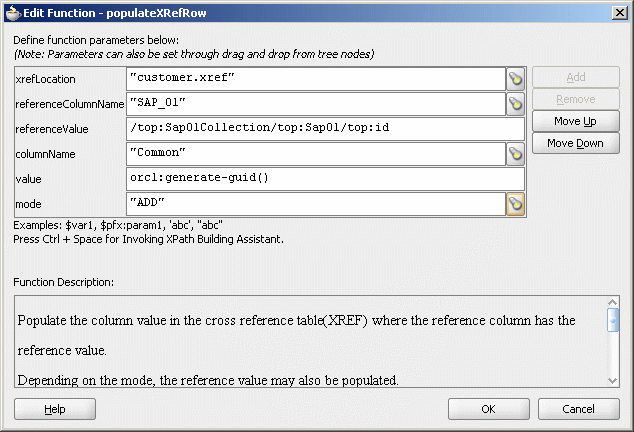
Description of "Figure 43-25 Edit Function – populateXRefRow Dialog: XrefCustApp Use Case" -
Click OK.
-
From the File menu, select Save All and close the SAP_TO_COMMON_INSERT.xsl file.
The Routing Rules section appears, as shown in Figure 43-26.
Figure 43-26 Routing Rules Section with Insert Operation
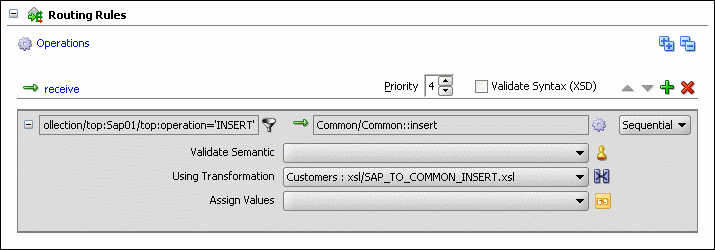
Description of "Figure 43-26 Routing Rules Section with Insert Operation"
43.8.1.8.2 To create routing rules for an update operation:
-
In the Routing Rules section, click the Create a new Routing Rule icon.
The Target Type dialog is displayed.
-
Select Service.
The Target Services dialog is displayed.
-
Navigate to XrefCustApp > Mediators > Common, Services > Common.
-
Select Update and click OK.
-
Click the Filter icon.
The Expression Builder dialog is displayed.
-
In the Expression field, enter the following expression:
$in.Sap01Collection/top:Sap01Collection/top:Sap01/top:operation='UPDATE'
-
Click OK.
-
Next to the Transform Using field, click the Transformation icon.
The Request Transformation map dialog is displayed.
-
Select Create New Mapper File and enter
SAP_TO_COMMON_UPDATE.xsl. -
Click OK.
An SAP_TO_COMMON_UPDATE.xsl file is displayed.
-
Drag and drop the top:Sap01 source element to the inp1:Customer target element.
The Auto Map Preferences dialog is displayed.
-
Click OK.
-
From the Components window, select Advanced.
-
Select XREF Functions.
-
Drag and drop the lookupXRef function from the Components window to the line connecting the top:id and inp1:id elements.
-
Double-click the lookupXRef icon.
The Edit Function-lookupXRef dialog is displayed.
-
To the right of the xrefLocation field, click Search.
The SOA Resource Lookup dialog is displayed.
-
Select customer.xref and click OK.
-
In the referenceColumnName field, enter
"SAP_01"or click Search to select the column name. -
In the referenceValue column, enter
/top:Sap01Collection/top:Sap01/top:id. -
In the columnName field, enter
"COMMON"or click Search to select the column name. -
In the needException field, enter
true()or click Search to select this mode.Figure 43-27 shows the populated Edit Function – looupXRef dialog.
Figure 43-27 Edit Function – lookupXRef Dialog: XrefCustApp Use Case
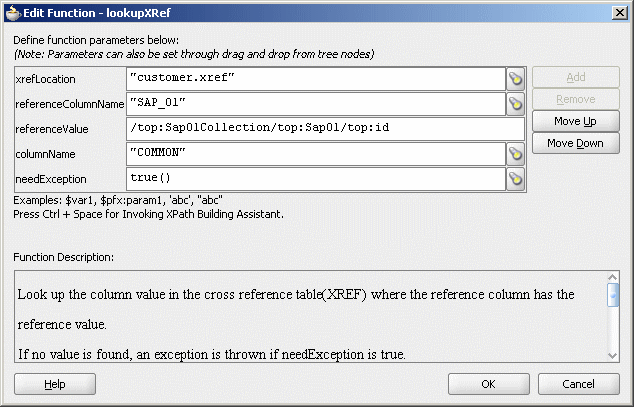
Description of "Figure 43-27 Edit Function – lookupXRef Dialog: XrefCustApp Use Case" -
Click OK.
-
From the File menu, select Save All and close the SAP_TO_COMMON_UPDATE.xsl file.
The Routing Rules section appears, as shown in Figure 43-28.
Figure 43-28 Insert Operation and Update Operation
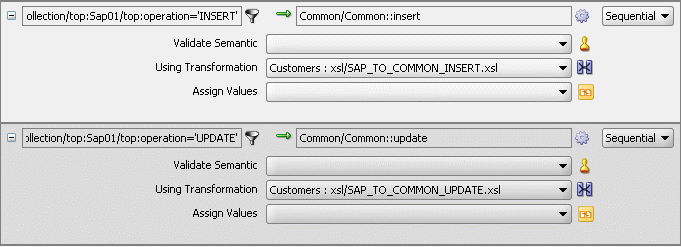
Description of "Figure 43-28 Insert Operation and Update Operation"
43.8.1.8.3 To create routing rules for an updateID operation:
Perform the following tasks to create routing rules for an updateID operation:
-
In the Routing Rules section, click the Create a new Routing Rule icon.
The Target Type dialog is displayed.
-
Select Service.
The Target Services dialog is displayed.
-
Navigate to XrefCustApp > Mediators > Common, Services > Common.
-
Select updateid and click OK.
-
Click the Filter icon.
The Expression Builder dialog is displayed.
-
In the Expression field, enter the following expression:
$in.Sap01Collection/top:Sap01Collection/top:Sap01/top:operation = 'UPDATEID'
-
Click OK.
-
Next to the Transform Using field, click the Transformation icon.
The Request Transformation map dialog is displayed.
-
Select Create New Mapper File and enter
SAP_TO_COMMON_UPDATEID.xsl. -
Click OK.
An SAP_TO_COMMON_UPDATEID.xsl file is displayed.
-
Drag and drop the top:Sap01 source element to the inp1:Customer target element.
The Auto Map Preferences dialog is displayed.
-
Click OK.
-
From the Components window, select Advanced.
-
Select XREF Functions.
-
Drag and drop the populateXRefRow function from the Components window to the line connecting the top:id and inp1:id elements.
-
Double-click the populateXRefRow icon.
The Edit Function-populateXRefRow dialog is displayed.
-
To the right of the xrefLocation field, click Search.
The SOA Resource Lookup dialog is displayed.
-
Select customer.xref and click OK.
-
In the referenceColumnName field, enter
"SAP_01"or click Search to select the column name. -
In the referenceValue column, enter
/top:Sap01Collection/top:Sap01/top:refId. -
In the columnName field, enter
"SAP_01"or click Search to select the column name. -
In the value field, enter
/top:Sap01Collection/top:Sap01/top:Id. -
In the mode field, enter
"UPDATE"or click Search to select this mode.Figure 43-29 shows a populated Edit Function – populateXRefRow dialog.
Figure 43-29 Edit Function – populateXRefRow Dialog: XrefCustApp Use Case
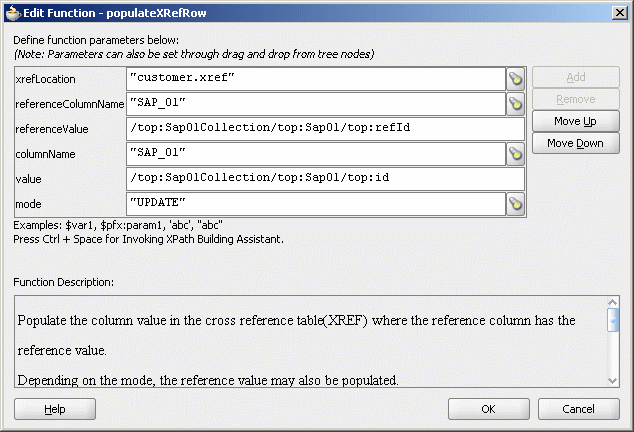
Description of "Figure 43-29 Edit Function – populateXRefRow Dialog: XrefCustApp Use Case" -
Drag and drop the lookupXRef function from the Components window to the line connecting the top:id and inp1:id elements.
-
Double-click the lookupXRef icon.
The Edit Function-lookupXRef dialog is displayed.
-
To the right of the xrefLocation field, click Search.
The SOA Resource Lookup dialog is displayed.
-
Select customer.xref and click OK.
-
In the referenceColumnName field, enter
"SAP_01"or click Search to select the column name. -
In the referenceValue column, enter the following:
xref:populateXRefRow("customer.xref","SAP_ 01",/top:Sap01Collection/top:Sap01/top:refId,"SAP_01",/top:Sap01Collection/top:Sap01/top:id,"UPDATE"). -
In the columnName field, enter
"COMMON"or click Search to select the column name. -
In the needException field, enter
false()or click Search to select this mode.Figure 43-30 shows a populated Edit Function – lookupXRef dialog.
Figure 43-30 Edit Function – lookupXRef Dialog: XrefCustApp Use Case
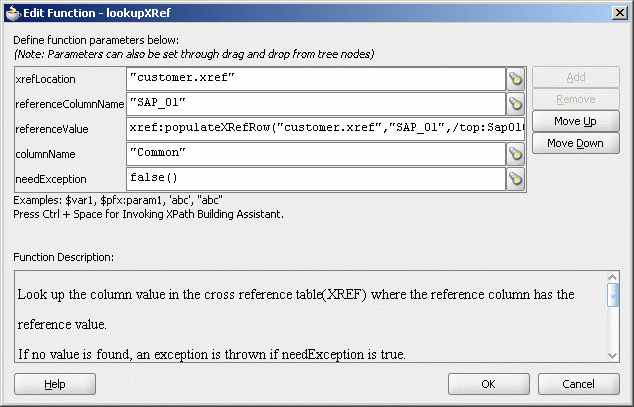
Description of "Figure 43-30 Edit Function – lookupXRef Dialog: XrefCustApp Use Case" -
Click OK.
-
From the File menu, select Save All and close the SAP_TO_COMMON_UPDATEID.xsl file.
The Routing Rules section appears, as shown in Figure 43-31.
Figure 43-31 Insert, Update, and UpdateID Operations
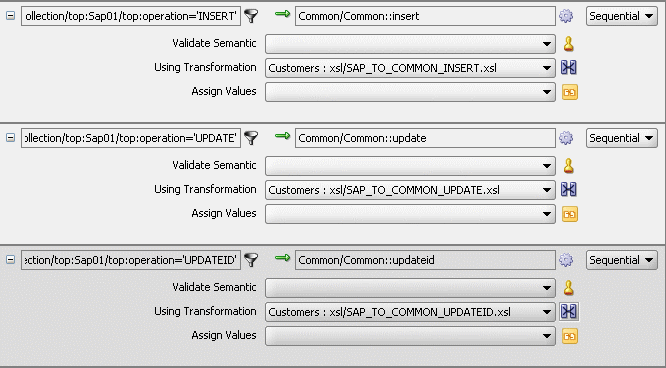
Description of "Figure 43-31 Insert, Update, and UpdateID Operations"
43.8.1.8.4 To create routing rules for a delete operation:
-
In the Routing Rules section, click the Create a new Routing Rule icon.
The Target Type dialog is displayed.
-
Select Service.
The Target Services dialog is displayed.
-
Navigate to XrefCustApp > Mediators > Common, Services > Common.
-
Select delete and click OK.
-
Click the Filter icon.
The Expression Builder dialog is displayed.
-
In the Expression field, enter the following expression:
$in.Sap01Collection/top:Sap01Collection/top:Sap01/top:operation = 'DELETE'
-
Click OK.
-
Next to the Transform Using field, click the Transformation icon.
The Request Transformation map dialog is displayed.
-
Select Create New Mapper File and enter
SAP_TO_COMMON_DELETE.xsl. -
Click OK.
A SAP_TO_COMMON_DELETE.xsl file is displayed.
-
Right-click <sources> and select Add Parameter.
The Add Parameter dialog is displayed.
-
In the Local Name field, enter
COMMONID. -
Select Set Default Value.
-
Select Expression.
-
In the XPath Expression field, enter
xref:lookupXRef("customer.xref","SAP_ 01",/top:Sap01Collection/top:Sap01/top:id,"COMMON",false()). -
Click OK.
-
Drag and drop the top:Sap01 source element to the inp1:Customer target element.
The Auto Map Preferences dialog is displayed.
-
Click OK.
-
Delete the line connecting top:id and inp1:id.
-
Connect COMMONID to inp1:id.
-
Right-click inp1:id and select Add XSL node and then if.
A new node
ifis inserted betweeninp1:customerandinp1:id. -
Connect top:id to the if node.
-
From the Components window, select Advanced.
-
Select XREF Functions.
-
Drag and drop the markForDelete function from the Components window to the line connecting top:id and the if node.
-
Double-click the markForDelete icon.
The Edit Function-markForDelete dialog is displayed.
-
Click Search to the right of the xrefLocation field.
The SOA Resource Lookup dialog is displayed.
-
Select customer.xref and click OK.
-
In the columnName field, enter
"SAP_01"or click Search to select the column name. -
In the value field, enter
/top:Sap01Collection/top:Sap01/top:Id.Figure 43-32 shows a populated Edit Function – markForDelete dialog.
Figure 43-32 Edit Function – markForDelete Dialog: XrefCustApp Use Case

Description of "Figure 43-32 Edit Function – markForDelete Dialog: XrefCustApp Use Case" -
Click OK.
The SAP_TO_COMMON_DELETE.xsl file appears, as shown in Figure 43-33.
-
From the File menu, select Save All and close the SAP_TO_COMMON_DELETE.xsl file.
The Routing Rules section appears, as shown in Figure 43-34.
Figure 43-34 Insert, Update, UpdateID, and Delete Operations
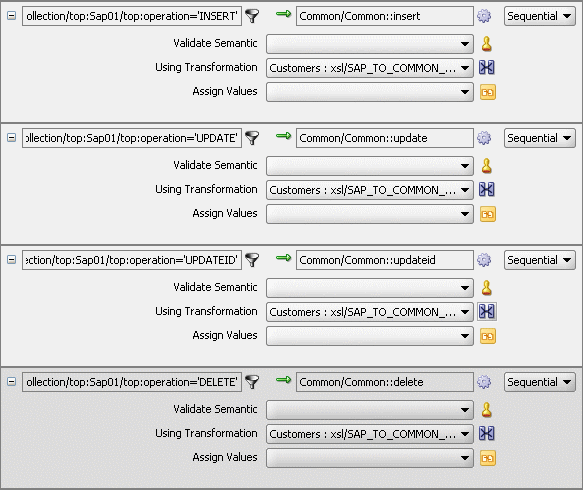
Description of "Figure 43-34 Insert, Update, UpdateID, and Delete Operations"
43.8.1.9 Task 9: How to Specify Routing Rules for the Common Oracle Mediator
You must specify routing rules for the following operations of the Common Oracle Mediator:
-
Insert
-
Delete
-
Update
-
UpdateID
43.8.1.9.1 To create routing rules for the insert operation:
-
Double-click the Common Oracle Mediator.
The Mediator Editor is displayed.
-
In the Routing Rules section, click the Create a new Routing Rule icon.
The Target Type dialog is displayed.
-
Select Service.
The Target Services dialog is displayed.
-
Navigate to XrefCustApp > References > SBL.
-
Select SBL and click OK.
-
Next to the Transform Using field, click the Transformation icon.
The Request Transformation map dialog is displayed.
-
Select Create New Mapper File and enter
COMMON_TO_SBL_INSERT.xsl. -
Click OK.
A COMMON_TO_SBL_INSERT.xsl file is displayed.
-
Drag and drop the inp1:Customers source element to the db:InputParameters target element.
The Auto Map Preferences dialog is displayed.
-
Click OK.
The transformation is created, as shown in Figure 43-35.
Figure 43-35 COMMON_TO_SBL_INSERT.xsl Transformation

Description of "Figure 43-35 COMMON_TO_SBL_INSERT.xsl Transformation" -
From the File menu, select Save All and close the COMMON_TO_SBL_INSERT.xsl file.
-
In the Synchronous Reply section, click Browse for target service operations.
The Target Type dialog is displayed.
-
Select Service.
The Target Services dialog is displayed.
-
Navigate to XrefCustApp > References > Logger.
-
Select Write and click OK.
-
Next to the Transform Using field, click the Transformation icon.
The Reply Transformation map dialog is displayed.
-
Select Create New Mapper File and enter
SBL_TO_COMMON_INSERT.xsl. -
Select Include Request in the Reply Payload.
-
Click OK.
A SBL_TO_COMMON_INSERT.xsl file is displayed.
-
Connect the inp1:Customers source element to db:X:APP_ID.
-
Drag and drop the populateXRefRow function from the Components window to the connecting line.
-
Double-click the populateXRefRow icon.
The Edit Function-populateXRefRow dialog is displayed.
-
Enter this information in the following fields:
-
xrefLocation:
"customer.xref" -
referenceColumnName:
"Common" -
referenceValue:
$initial.Customers/inp1:Customers/inp1:Customer/inp1:Id -
columnName:
"SBL_78" -
value:
/db:OutputParameters/db:X_APP_ID -
mode:
"LINK"
-
-
Click OK.
The SBL_TO_COMMON_INSERT.xsl file appears, as shown in Figure 43-36.
Figure 43-36 SBL_TO_COMMON_INSERT.xsl Transformation

Description of "Figure 43-36 SBL_TO_COMMON_INSERT.xsl Transformation" -
From the File menu, select Save All and close the SBL_TO_COMMON_INSERT.xsl file.
-
In the Synchronous Reply section, click the Assign Values icon.
The Assign Values dialog is displayed.
-
Click Add.
The Assign Value dialog is displayed.
-
In the From section, select Expression.
-
Click the Invoke Expression Builder icon.
The Expression Builder dialog is displayed.
-
In the Expression field, enter the following expression and click OK.
concat('INSERT-',$in.OutputParameters/db:OutputParameters/db:X_APP_ID,'.xml') -
In the To section, select Property.
-
Select the jca.file.FileName property and click OK.
-
Click OK.
The insert operation section appears, as shown in Figure 43-37.
Figure 43-37 Insert Operation with SBL Target Service

Description of "Figure 43-37 Insert Operation with SBL Target Service" -
From the File menu, select Save All.
-
Repeat Step 2 through Step 34 to specify another target service named EBS and its routing rules.
Figure 43-38 shows the insert operation section with SBL and EBS target services.
Figure 43-38 Insert Operation with SBL and EBS Target Services
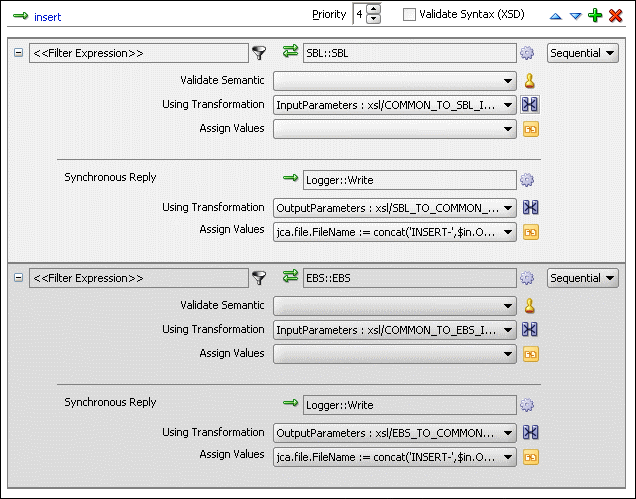
Description of "Figure 43-38 Insert Operation with SBL and EBS Target Services"
43.8.1.9.2 To create routing rules for a delete operation:
Perform the following tasks to create the routing rules for a delete operation.
-
In the Routing Rules section, click the Create a new Routing Rule icon.
The Target Type dialog is displayed.
-
Select Service.
The Target Services dialog is displayed.
-
Navigate to XrefCustApp > References > SBL.
-
Select SBL and click OK.
-
Next to the Transform Using field, click the Transformation icon.
The Request Transformation map dialog is displayed.
-
Select Create New Mapper File and enter
COMMON_TO_SBL_DELETE.xsl. -
Click OK.
A COMMON_TO_SBL_DELETE.xsl file is displayed.
-
Drag and drop the inp1:Customers source element to the db:InputParameters target element.
The Auto Map Preferences dialog is displayed.
-
Click OK.
The transformation is created, as shown in Figure 43-39.
Figure 43-39 COMMON_TO_SBL_DELETE.xsl Transformation

Description of "Figure 43-39 COMMON_TO_SBL_DELETE.xsl Transformation" -
Drag and drop the lookupXRef function from the Components window to the line connecting inp1:id and db:XCUSTOMER_ID.
-
Double-click the lookupXRef icon.
The Edit Function: lookupXRef dialog is displayed.
-
Enter this information in the following fields:
-
xrefLocation:
"customer.xref" -
referenceColumnName:
"Common" -
referenceValue:
/inp1:Customers/inp1:Customer/inp1:Id -
columnName:
"SBL_78" -
needException:
false()
-
-
Click OK.
-
From the File menu, select Save All and close the COMMON_TO_SBL_DELETE.xsl file.
-
In the Synchronous Reply section, click Browse for target service operations.
The Target Type dialog is displayed.
-
Select Service.
The Target Services dialog is displayed.
-
Navigate to XrefCustApp > References > Logger.
-
Select Write and click OK.
-
Next to the Transform Using field, click the Transformation icon.
The Reply Transformation map dialog is displayed.
-
Select Create New Mapper File and enter
SBL_TO_COMMON_DELETE.xsl. -
Click OK.
The SBL_TO_COMMON_DELETE.xsl file is displayed.
-
Connect the db:X_APP_ID source element to the db:X:APP_ID target.
-
Drag and drop the markForDelete function from the Components window to the connecting line.
-
Double-click the markForDelete icon.
The Edit Function-markForDelete dialog is displayed.
-
Enter this information in the following fields:
-
xrefLocation:
"customer.xref" -
columnName:
"SBL_78" -
value:
/db:OutputParameters/db:X_APP_ID
-
-
Click OK.
-
From the File menu, select Save All and close the SBL_TO_COMMON_DELETE.xsl file.
-
In the Synchronous Reply section, click the Assign Values icon.
The Assign Values dialog is displayed.
-
Click Add.
The Assign Value dialog is displayed.
-
In the From section, select Expression.
-
Click the Invoke Expression Builder icon.
The Expression Builder dialog is displayed.
-
In the Expression field, enter the following expression, and click OK.
concat('DELETE-',$in.OutputParameters/db:OutputParameters/db:X_APP_ID,'.xml') -
In the To section, select Property.
-
Select the jca.file.FileName property and click OK.
-
Click OK.
The delete operation section appears, as shown in Figure 43-40.
Figure 43-40 Delete Operation with SBL Target Service
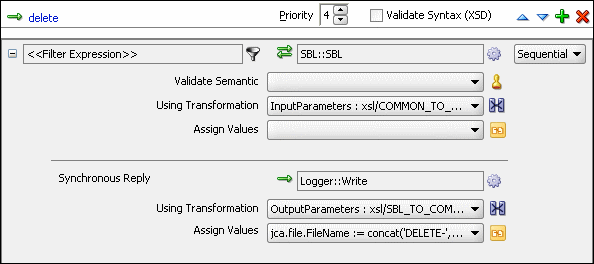
Description of "Figure 43-40 Delete Operation with SBL Target Service" -
From the File menu, select Save All.
-
Repeat Step 1 through Step 36 to specify another target service named EBS and specify the routing rules.
Figure 43-41 shows the delete operation section with SBL and EBS target services.
Figure 43-41 Delete Operation with SBL and EBS Target Service
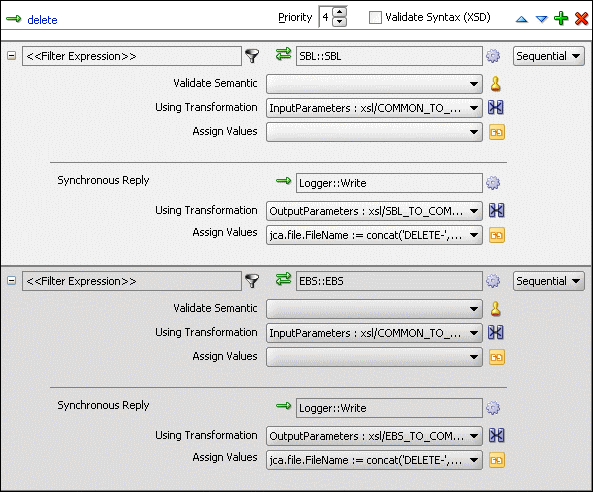
Description of "Figure 43-41 Delete Operation with SBL and EBS Target Service"
43.8.1.9.3 To create routing rules for the update operation:
Perform the following tasks to create routing rules for the update operation.
-
In the Routing Rules section, click the Create a new Routing Rule icon.
The Target Type dialog is displayed.
-
Select Service.
The Target Services dialog is displayed.
-
Navigate to XrefCustApp, References > SBL.
-
Select SBL and click OK.
-
Click the Transformation icon next to the Transform Using field.
The Request Transformation map dialog is displayed.
-
Select Create New Mapper File and enter
COMMON_TO_SBL_UPDATE.xsl. -
Click OK.
A COMMON_TO_SBL_UPDATE.xsl file is displayed.
-
Drag and drop the inp1:Customers source element to the db:InputParameters target element.
The Auto Map Preferences dialog is displayed.
-
Click OK.
The transformation is created, as shown in Figure 43-39.
-
Drag and drop the lookupXRef function from the Components window to the line connecting inp1:id and db:XCUSTOMER_ID.
-
Double-click the lookupXRef icon.
The Edit Function: lookupXRef dialog is displayed.
-
Enter this information in the following fields:
-
xrefLocation:
"customer.xref" -
referenceColumnName:
"Common" -
referenceValue:
/inp1:Customers/inp1:Customer/inp1:Id -
columnName:
"SBL_78" -
needException:
true()
-
-
Click OK.
-
From the File menu, select Save All and close the COMMON_TO_SBL_UPDATE.xsl file.
-
In the Synchronous Reply section, click Browse for target service operations.
The Target Type dialog is displayed.
-
Select Service.
The Target Services dialog is displayed.
-
Navigate to XrefCustApp > References > Logger.
-
Select Write and click OK.
-
Next to the Transform Using field, click the Transformation icon.
The Reply Transformation map dialog is displayed.
-
Select Create New Mapper File and enter
SBL_TO_COMMON_UPDATE.xsl. -
Click OK.
A SBL_TO_COMMON_UPDATE.xsl file is displayed.
-
Connect the db:X:APP_ID source element to db:X:APP_ID.
-
From the File menu, select Save All and close the SBL_TO_COMMON_UPDATE.xsl file.
-
In the Synchronous Reply section, click the Assign Values icon.
The Assign Values dialog is displayed.
-
Click Add.
The Assign Value dialog is displayed.
-
In the From section, select Expression.
-
Click the Invoke Expression Builder icon.
The Expression Builder dialog is displayed.
-
In the Expression field, enter the following expression and click OK.
concat('UPDATE-',$in.OutputParameters/db:OutputParameters/db:X_APP_ID,'.xml') -
In the To section, select Property.
-
Select the jca.file.FileName property and click OK.
-
Click OK.
The update operation section appears, as shown in Figure 43-42.
Figure 43-42 Update Operation with SBL Target Service
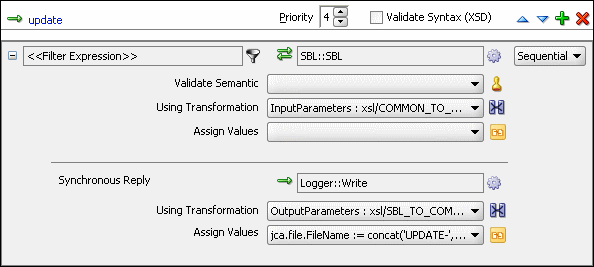
Description of "Figure 43-42 Update Operation with SBL Target Service" -
From the File menu, select Save All.
-
Repeat Step 1 through Step 32 to specify another target service named EBS and its routing rules.
Figure 43-43 shows the update operation section with SBL and EBS target services.
Figure 43-43 Update Operation with SBL and EBS Target Service

Description of "Figure 43-43 Update Operation with SBL and EBS Target Service"
43.8.1.9.4 To create routing rules for the UpdateID operation:
Perform the following tasks to create routing rules for the UpdateID operation.
-
In the Routing Rules section, click the Create a new Routing Rule icon.
The Target Type dialog is displayed.
-
Select Service.
The Target Services dialog is displayed.
-
Navigate to XrefCustApp > References > SBL.
-
Select SBL and click OK.
-
Next to the Transform Using field, click the Transformation icon.
The Request Transformation map dialog is displayed.
-
Select Create New Mapper File and enter
COMMON_TO_SBL_UPDATEID.xsl. -
Click OK.
The COMMON_TO_SBL_UPDATEID.xsl file is displayed.
-
Drag and drop the inp1:Customers source element to the db:InputParameters target element.
The Auto Map Preferences dialog is displayed.
-
Click OK.
The transformation is created, as shown in Figure 43-39.
-
Drag and drop the lookupXRef function from the Components window to the line connecting inp1:id and db:X_CUSTOMER_ID.
-
Double-click the lookupXRef icon.
The Edit Function: lookupXRef dialog is displayed.
-
Enter this information in the following fields:
-
xrefLocation:
customer.xref -
referenceColumnName:
Common -
referenceValue:
/inp1:Customers/inp1:Customer/inp1:Id -
columnName:
SBL_78 -
needException:
false()
-
-
Click OK.
-
From the File menu, select Save All and close the COMMON_TO_SBL_UPDATEID.xsl file.
-
In the Synchronous Reply section, click Browse for target service operations.
The Target Type dialog is displayed.
-
Select Service.
The Target Services dialog is displayed.
-
Navigate to XrefCustApp > References > Logger.
-
Select Write and click OK.
-
Next to the Transform Using field, click the Transformation icon.
The Reply Transformation map dialog is displayed.
-
Select Include Request in the Reply Payload.
-
Click OK.
The SBL_TO_COMMON_UPDATEID.xsl file is displayed.
-
Connect inp1:Customers source element to the db:X:APP_ID.
-
Drag and drop the populateXRefRow function from the Components window to the connecting line.
-
Double-click the populateXRefRow icon.
The Edit Function-populateXRefRow dialog is displayed.
-
Enter this information in the following fields:
-
xrefLocation:
customer.xref -
referenceColumnName:
Common -
referenceValue:
$initial.Customers/inp1:Customers/inp1:Customer/inp1:Id -
columnName:
SBL_78 -
value:
/db:OutputParameters/db:X_APP_ID -
mode:
UPDATE
-
-
Click OK.
-
From the File menu, select Save All and close the SBL_TO_COMMON_UPDATEID.xsl file.
-
In the Synchronous Reply section, click the Assign Values icon.
The Assign Values dialog is displayed.
-
Click Add.
The Assign Value dialog is displayed.
-
In the From section, select Expression.
-
Click the Invoke Expression Builder icon.
The Expression Builder dialog is displayed.
-
In the Expression field, enter the following expression and click OK.
concat('UPDATEID-',$in.OutputParameters/db:OutputParameters/db:X_APP_ID,'.xml') -
In the To section, select Property.
-
Select the jca.file.FileName property and click OK.
-
Click OK.
The updateid operation section appears, as shown in Figure 43-44.
Figure 43-44 Updateid Operation with SBL Target Service
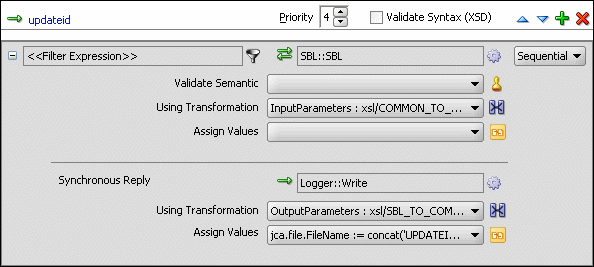
Description of "Figure 43-44 Updateid Operation with SBL Target Service" -
From the File menu, select Save All.
-
Repeat Step 1 through Step 36 to specify another target service named EBS and specify the routing rules.
Figure 43-45 shows the updateid operation section with the SBL and EBS target services.
Figure 43-45 Updateid Operation with SBL and EBS Target Service
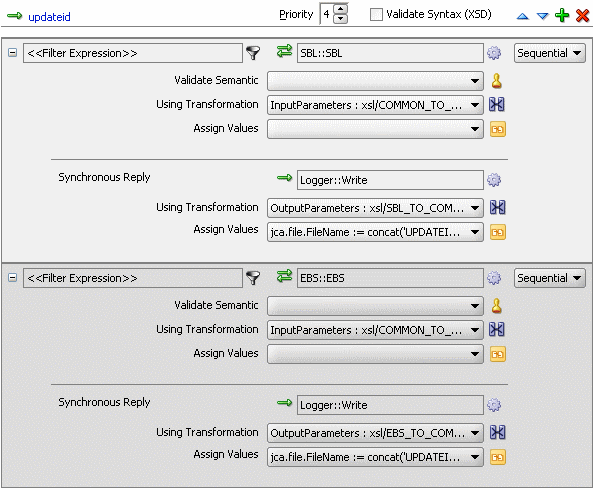
Description of "Figure 43-45 Updateid Operation with SBL and EBS Target Service"
43.8.1.10 Task 10: How to Configure an Application Server Connection
An application server connection is required for deploying your SOA composite application. For information on creating an application server connection, see Creating an Application Server Connection.
43.8.1.11 Task 11: How to Deploy the Composite Application
Deploying the XrefCustApp composite application consists of the following steps:
-
Creating an application deployment profile
-
Deploying the application to the application server
For detailed information about these steps, see How to Deploy a Single SOA Composite in Oracle JDeveloper.
43.8.2 How to Run and Monitor the XrefCustApp Application
After deploying the XrefCustApp application, you can run it by using any command from the insert_sap_record.sql file present in the XrefCustApp/sql folder. On successful completion, the records are inserted or updated in the EBS and SBL tables and the Logger reference writes the output to the output.xml file.
For monitoring the running instance, you can use the Oracle Enterprise Manager Fusion Middleware Control at the following URL:
http://hostname:port_number/em
where hostname is the host on which you installed the Oracle SOA Suite infrastructure and port_number is the port running the service.
43.9 Creating and Running Cross Reference for 1M Functions
The cross reference use case implements an integration scenario between two end-system Oracle EBS and SAP instances. In this use case, the order passes from SAP to EBS. SAP represents the orders with a unique ID, whereas EBS splits the order into two orders: ID1 and ID2. This scenario is created using database adapters. When you poll the SAP table for updated or created records, an SAP instance is created. In EBS, the instance is simulated by a procedure and the table is populated. Figure 43-46 provides an overview of this use case.
Figure 43-46 XrefOrderApp Use Case in SOA Composite Editor
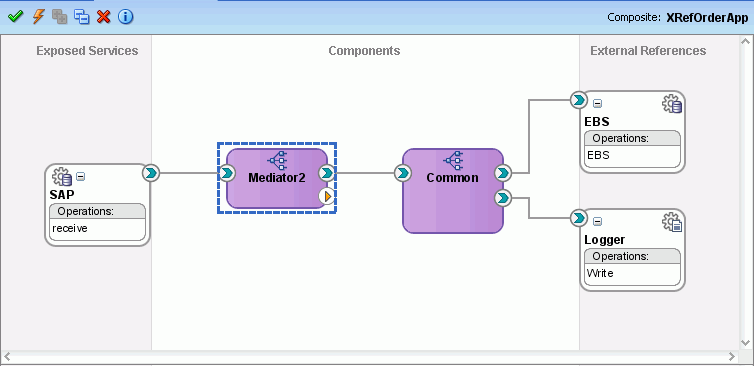
Description of "Figure 43-46 XrefOrderApp Use Case in SOA Composite Editor"
43.9.1 How to Create the Use Case
This section provides the design-time tasks for creating, building, and deploying your SOA composite application. These tasks should be performed in the order in which they are presented.
43.9.1.1 Task 1: How to Configure the Oracle Database and Database Adapter
To configure the Oracle database and database adapter:
43.9.1.2 Task 2: How to Create an Oracle JDeveloper Application and a Project
To create an Oracle JDeveloper application and a project:
43.9.1.3 Task 3: How to Create a Cross Reference
After creating an application and a project for the use case, you must create a cross reference table.
To create a cross reference table:
43.9.1.6 Task 6: How to Create a Logger File Adapter External Reference
To create a Logger file adapter external reference:
43.9.1.7 Task 7: How to Create an Oracle Mediator Service Component
To create an Oracle Mediator service component:
43.9.1.8 Task 8: How to Specify Routing Rules for an Oracle Mediator Component
You must specify routing rules for following operations:
-
Insert
-
Update
43.9.1.8.1 To create routing rules for the insert operation:
-
Double-click the Mediator2 Oracle Mediator.
The Mediator Editor is displayed.
-
In the Routing Rules section, click the Create a new Routing Rule icon.
The Target Type dialog is displayed.
-
Select Service.
The Target Services dialog is displayed.
-
Navigate to XrefOrderApp > Mediators > Common, Services > Common.
-
Select Insert and click OK.
-
Click the Filter icon.
The Expression Builder dialog is displayed.
-
In the Expression field, enter the following expression:
$in.Sap05Collection/top:Sap05Collection/top:Sap05/top:operation='INSERT'
-
Click OK.
-
Next to the Using Transformation field, click the Transformation icon.
The Request Transformation map dialog is displayed.
-
Select Create New Mapper File and enter
SAP_TO_COMMON_INSERT.xsl. -
Click OK.
An SAP_TO_COMMON_INSERT.xsl file is displayed.
-
Drag and drop the top:SAP05 source element to the inp1:Order target element.
The Auto Map Preferences dialog is displayed.
-
From the During Auto Map options list, deselect Match Elements Considering their Ancestor Names.
-
Click OK.
The transformation is created, as shown in Figure 43-54.
Figure 43-54 SAP_TO_COMMON_INSERT.xsl Transformation

Description of "Figure 43-54 SAP_TO_COMMON_INSERT.xsl Transformation" -
From the Components window, select Advanced.
-
Select XREF Functions.
-
Drag and drop the populateXRefRow1M function from the Components window to the line connecting the top:id and inp1:id elements.
-
Double-click the populateXRefRow1M icon.
The Edit Function-populateXRefRow dialog is displayed.
-
To the right of the xrefLocation field, click Search.
The SOA Resource Lookup dialog is displayed.
-
Select Order.xref and click OK.
-
In the referenceColumnName field, enter
"SAP_05"or click Search to select the column name. -
In the referenceValue column, enter
/top:Sap05Collection/top:Sap05/top:id. -
In the columnName field, enter
"Common"or click Search to select the column name. -
In the value field, enter
orcl:generate-guid(). -
In the mode field, enter
"Add"or click Search to select this mode.Figure 43-55 shows the populated Edit Function – populateXRefRow1M dialog.
Figure 43-55 Edit Function – populateXRefRow1M Dialog: XrefOrderApp Use Case

Description of "Figure 43-55 Edit Function – populateXRefRow1M Dialog: XrefOrderApp Use Case" -
Click OK.
-
From the File menu, select Save All and close the SAP_TO_COMMON_INSERT.xsl file.
The Routing Rules section appears, as shown in Figure 43-56.
Figure 43-56 Routing Rules Section with Insert Operation
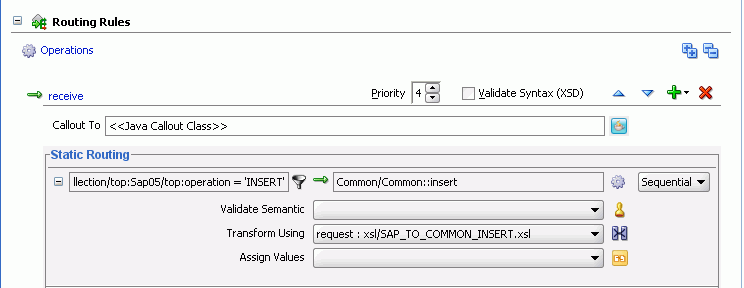
Description of "Figure 43-56 Routing Rules Section with Insert Operation"
43.9.1.8.2 To create routing rules for the update operation:
Perform the following tasks to create routing rules for the update operation.
-
In the Routing Rules section, click the Create a new Routing Rule icon.
The Target Type dialog is displayed.
-
Select Service.
The Target Services dialog is displayed.
-
Navigate to XrefOrderApp > Mediators > Common, Services > Common.
-
Select Update and click OK.
-
Click the Filter icon.
The Expression Builder dialog is displayed.
-
In the Expression field, enter the following expression:
$in.Sap05Collection/top:Sap05Collection/top:Sap05/top:operation='UPDATE'
-
Click OK.
-
Next to the Transform Using field, click the Transformation icon.
The Request Transformation map dialog is displayed.
-
Select Create New Mapper File and enter
SAP_TO_COMMON_UPDATE.xsl. -
Click OK.
An SAP_TO_COMMON_UPDATE.xsl file is displayed.
-
Drag and drop the top:Sap05 source element to the inp1:Order target element.
The Auto Map Preferences dialog is displayed.
-
Click OK.
-
From the Components window, select Advanced.
-
Select XREF Functions.
-
Drag and drop the lookupXRef function from the Components window to the line connecting the top:id and inp1:id elements.
-
Double-click the lookupXRef icon.
The Edit Function-lookupXRef dialog is displayed.
-
To the right of the xrefLocation field, click Search.
The SOA Resource Lookup dialog is displayed.
-
Select customer.xref and click OK.
-
In the referenceColumnName field, enter
"SAP_05"or click Search to select the column name. -
In the referenceValue column, enter
/top:Sap05Collection/top:Sap05/top:id. -
In the columnName field, enter
"COMMON"or click Search to select the column name. -
In the needException field, enter
true()or click Search to select this mode.Figure 43-57 shows the populated Edit Function – looupXRef dialog.
Figure 43-57 Edit Function – looupXRef Dialog: XRefOrderApp Use Case

Description of "Figure 43-57 Edit Function – looupXRef Dialog: XRefOrderApp Use Case" -
Click OK.
-
From the File menu, select Save All and close the SAP_TO_COMMON_UPDATE.xsl file.
The Routing Rules section appears, as shown in Figure 43-58.
Figure 43-58 Insert Operation and Update Operation
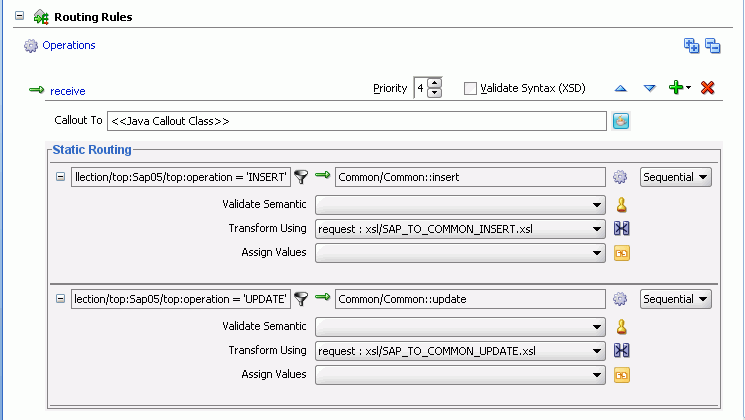
Description of "Figure 43-58 Insert Operation and Update Operation"
43.9.1.9 Task 9: How to Specify Routing Rules for the Common Oracle Mediator
You must specify routing rules for the following operations of the Common Oracle Mediator:
-
Insert
-
Update
43.9.1.9.1 To create routing rules for the insert operation:
-
Double-click the Common Oracle Mediator.
The Mediator Editor is displayed.
-
In the Routing Rules section, click the Create a new Routing Rule icon.
The Target Type dialog is displayed.
-
Select Service.
The Target Services dialog is displayed.
-
Navigate to XrefOrderApp > References > EBS.
-
Select EBS and click OK.
-
Next to the Transform Using field, click the Transformation icon.
The Request Transformation map dialog is displayed.
-
Select Create New Mapper File and enter
COMMON_TO_EBS_INSERT.xsl. -
Click OK.
A COMMON_TO_EBS_INSERT.xsl file is displayed.
-
Drag and drop the inp1:Order source element to the db:InputParameters target element.
The Auto Map Preferences dialog is displayed.
-
Set the value of the db:X_APP_INSTANCE node on the right side to EBS_i75.
Click OK.
The transformation is created, as shown in Figure 43-59.
Figure 43-59 COMMON_TO_EBS_INSERT.xsl Transformation

Description of "Figure 43-59 COMMON_TO_EBS_INSERT.xsl Transformation" -
From the File menu, select Save All and close the COMMON_TO_EBS_INSERT.xsl file.
-
In the Synchronous Reply section, click Browse for target service operations.
The Target Type dialog is displayed.
-
Select Service.
The Target Services dialog is displayed.
-
Navigate to XrefOrderApp > References > Logger.
-
Select Write and click OK.
-
Next to the Transform Using field, click the Transformation icon.
The Reply Transformation map dialog is displayed.
-
Select Create New Mapper File and enter
EBS_TO_COMMON_INSERT.xsl. -
Select Include Request in the Reply Payload.
-
Click OK.
An EBS_TO_COMMON_INSERT.xsl file is displayed.
-
Connect the inp1:Order source element to db:X:APP_ID.
-
Drag and drop the populateXRefRow function from the Components window to the connecting line.
-
Double-click the populateXRefRow icon.
The Edit Function-populateXRefRow dialog is displayed.
-
Enter this information in the following fields:
-
xrefLocation:
order.xref -
referenceColumnName:
Common -
referenceValue:
$initial.Customers/inp1:Customers/inp1:Order/inp1:Id -
columnName:
EBS_75 -
value:
/db:OutputParameters/db:X_APP_ID -
mode:
LINK
-
-
Click OK.
The EBS_TO_COMMON_INSERT.xsl file appears, as shown in Figure 43-60.
Figure 43-60 EBS_TO_COMMON_INSERT.xsl Transformation

Description of "Figure 43-60 EBS_TO_COMMON_INSERT.xsl Transformation" -
From the File menu, select Save All and close the EBS_TO_COMMON_INSERT.xsl file.
-
In the Synchronous Reply section, click the Assign Values icon.
The Assign Values dialog is displayed.
-
Click Add.
The Assign Value dialog is displayed.
-
In the From section, select Expression.
-
Click the Invoke Expression Builder icon.
The Expression Builder dialog is displayed.
-
In the Expression field, enter the following expression and click OK.
concat('INSERT-',$in.OutputParameters/db:OutputParameters/db:X_APP_ID,'.xml') -
In the To section, select Property.
-
Select the jca.file.FileName property and click OK.
-
Click OK.
The insert operation section appears, as shown in Figure 43-61.
Figure 43-61 Insert Operation with EBS Target Service
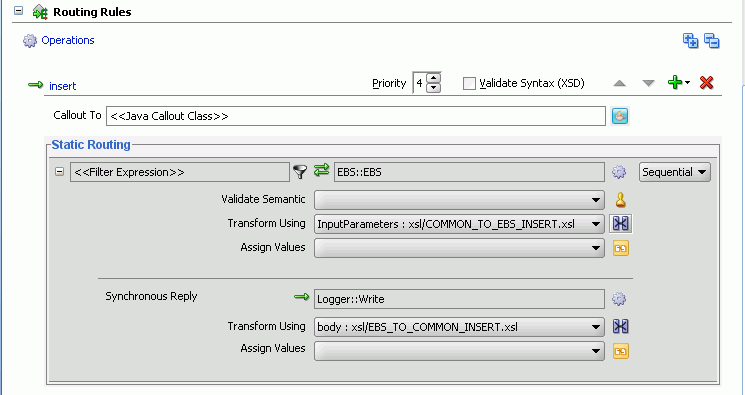
Description of "Figure 43-61 Insert Operation with EBS Target Service" -
From the File menu, select Save All.
43.9.1.9.2 To create routing rules for the update operation:
Perform the following tasks to create routing rules for the update operation.
-
In the Routing Rules section, click the Create a new Routing Rule icon.
The Target Type dialog is displayed.
-
Select Service.
The Target Services dialog is displayed.
-
Navigate to XrefOrderApp > References > EBS.
-
Select EBS and click OK.
-
Click the Transformation icon next to the Transform Using field.
The Request Transformation map dialog is displayed.
-
Select Create New Mapper File and enter
COMMON_TO_EBS_UPDATE.xsl. -
Click OK.
The COMMON_TO_EBS_UPDATE.xsl file is displayed.
-
Drag and drop the inp1:Orders source element to the db:InputParameters target element.
The Auto Map Preferences dialog is displayed.
-
Click OK.
The transformation is created, as shown in Figure 43-39.
-
Drag and drop the lookupXRef function from the Components window to the line connecting inp1:id and db:X_APP_ID.
-
Double-click the lookupXRef icon.
The Edit Function: lookupXRef dialog is displayed.
-
Enter this information in the following fields:
-
xrefLocation:
order.xref -
referenceColumnName:
Common -
referenceValue:
/inp1:Customers/inp1:Order/inp1:Id -
columnName:
EBS_i75 -
needException:
true()
-
-
Click OK.
-
From the File menu, select Save All and close the COMMON_TO_EBS_UPDATE.xsl file.
-
In the Synchronous Reply section, click Browse for target service operations.
The Target Type dialog is displayed.
-
Select Service.
The Target Services dialog is displayed.
-
Navigate to XrefOrderApp > References > Logger.
-
Select Write and click OK.
-
Next to the Transform Using field, click the Transformation icon.
The Reply Transformation map dialog is displayed.
-
Select Create New Mapper File and enter
EBS_TO_COMMON_UPDATE.xsl. -
Click OK.
The EBS_TO_COMMON_UPDATE.xsl file is displayed.
-
Connect the db:X:APP_ID source element to db:X:APP_ID.
-
From the File menu, select Save All and close the EBS_TO_COMMON_UPDATE.xsl file.
-
In the Synchronous Reply section, click the Assign Values icon.
The Assign Values dialog is displayed.
-
Click Add.
The Assign Value dialog is displayed.
-
In the From section, select Expression.
-
Click the Invoke Expression Builder icon.
The Expression Builder dialog is displayed.
-
In the Expression field, enter the following expression, and click OK.
concat('UPDATE-',$in.OutputParameters/db:OutputParameters/db:X_APP_ID,'.xml') -
In the To section, select Property.
-
Select the jca.file.FileName property and click OK.
-
Click OK.
The update operation section appears, as shown in Figure 43-62.
Figure 43-62 Update Operation with EBS Target Service
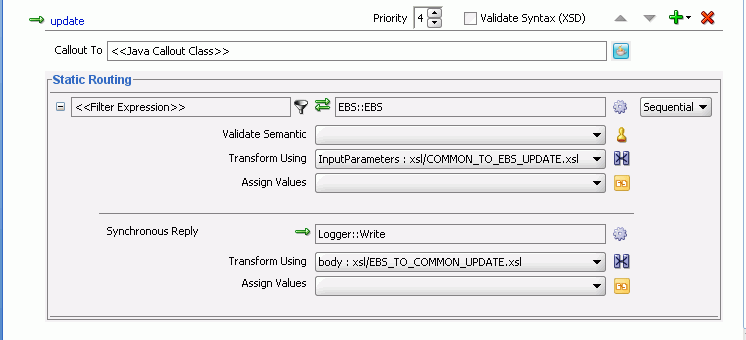
Description of "Figure 43-62 Update Operation with EBS Target Service" -
From the File menu, select Save All.
43.9.1.10 Task 10: How to Configure an Application Server Connection
An application server connection is required for deploying your SOA composite application. For information about creating an application server connection, see Creating an Application Server Connection.
43.9.1.11 Task 11: How to Deploy the Composite Application
Deploying the XrefOrderApp composite application to the application server consists of the following steps:
-
Creating an application deployment profile
-
Deploying the application to the application server
For detailed information about these steps, see How to Deploy a Single SOA Composite in Oracle JDeveloper.
